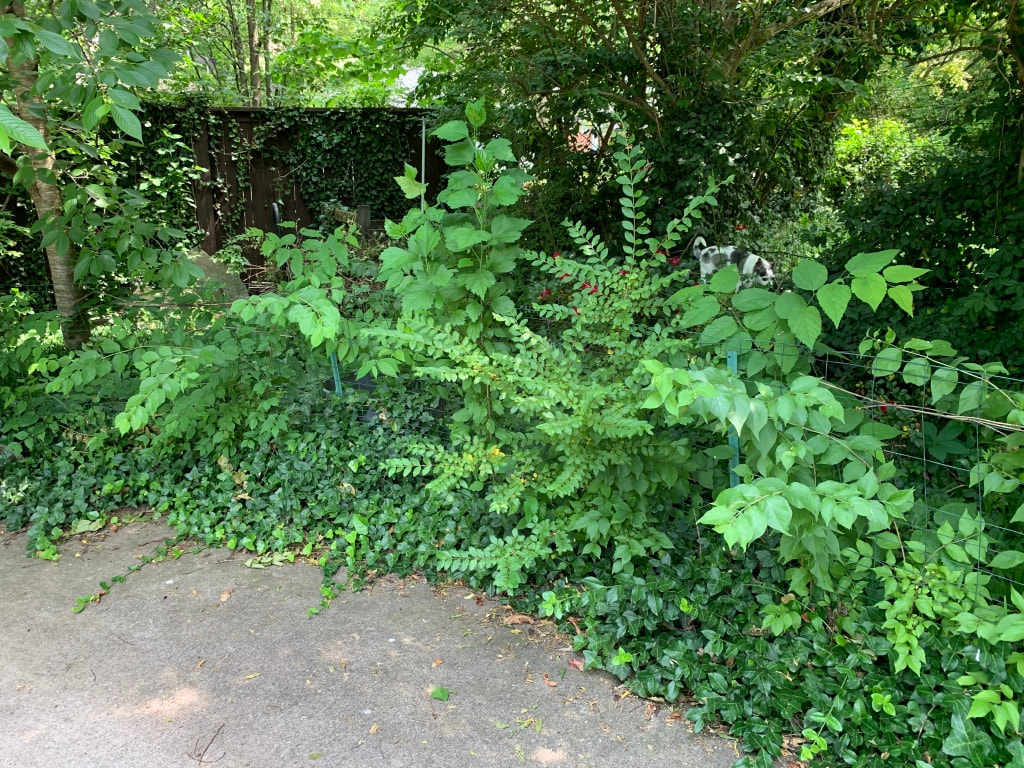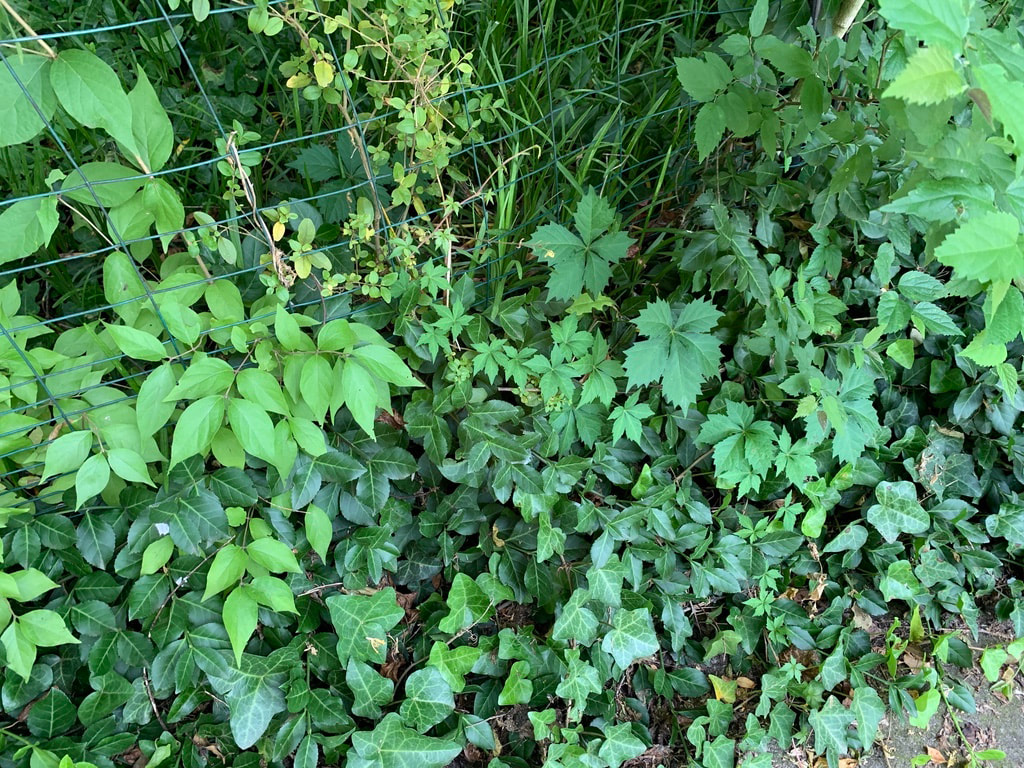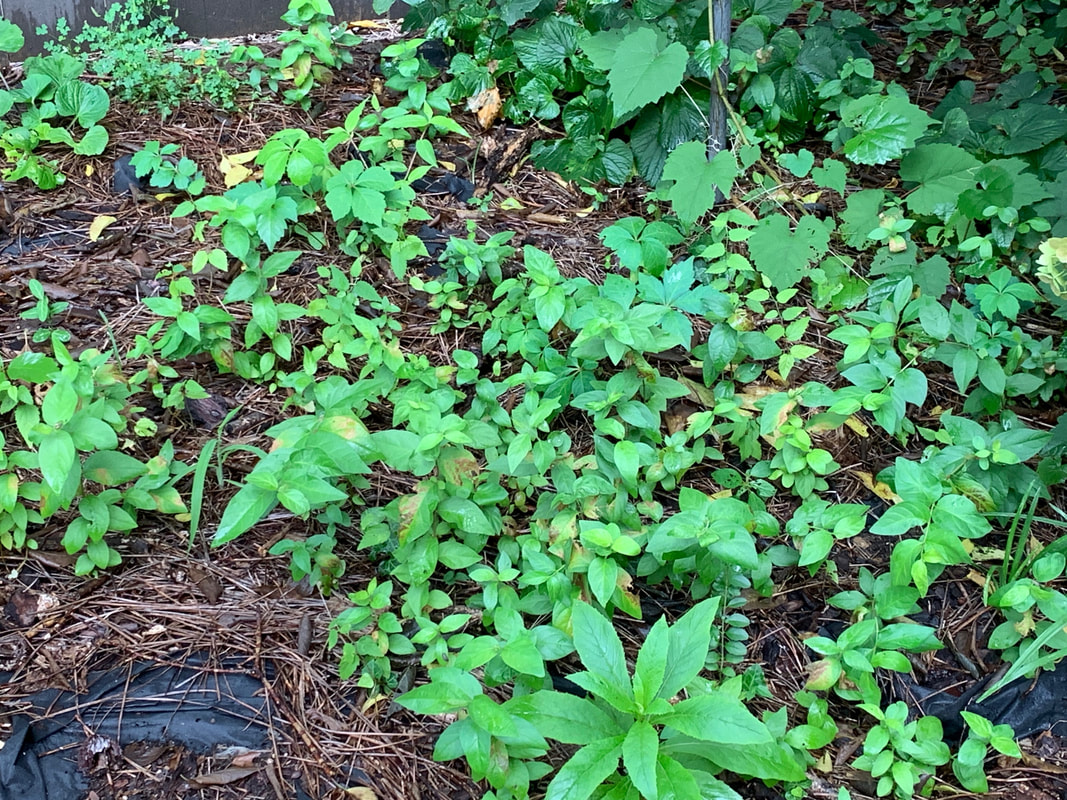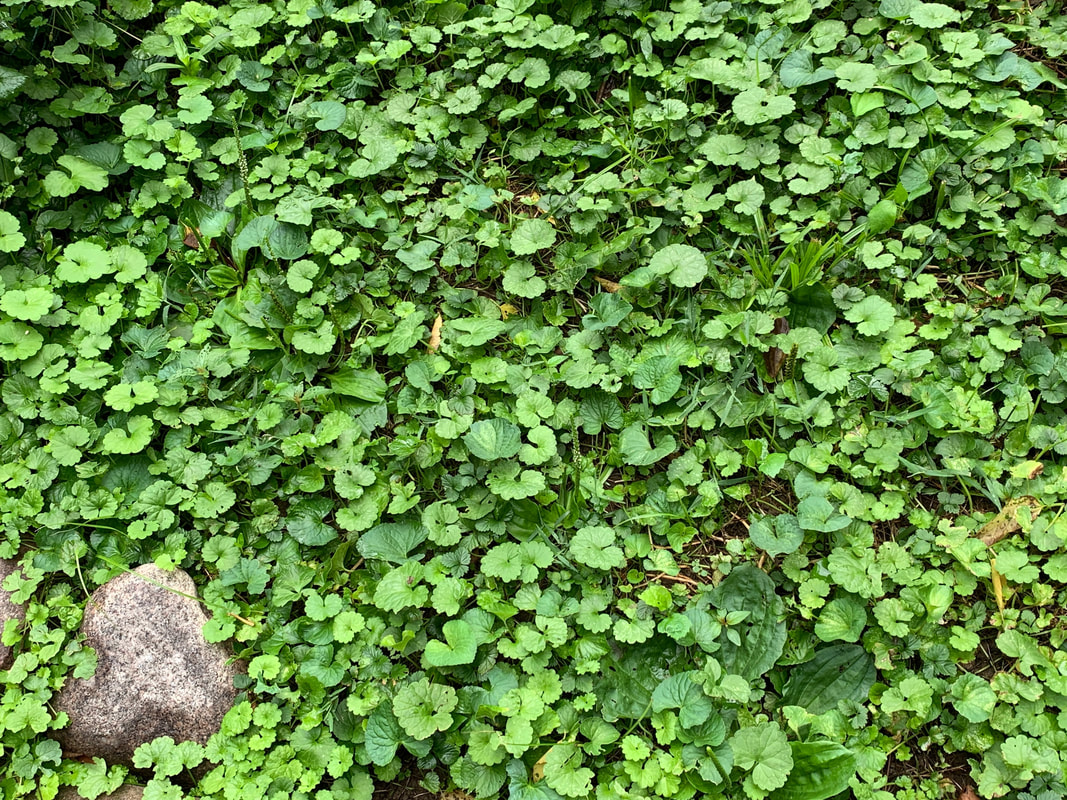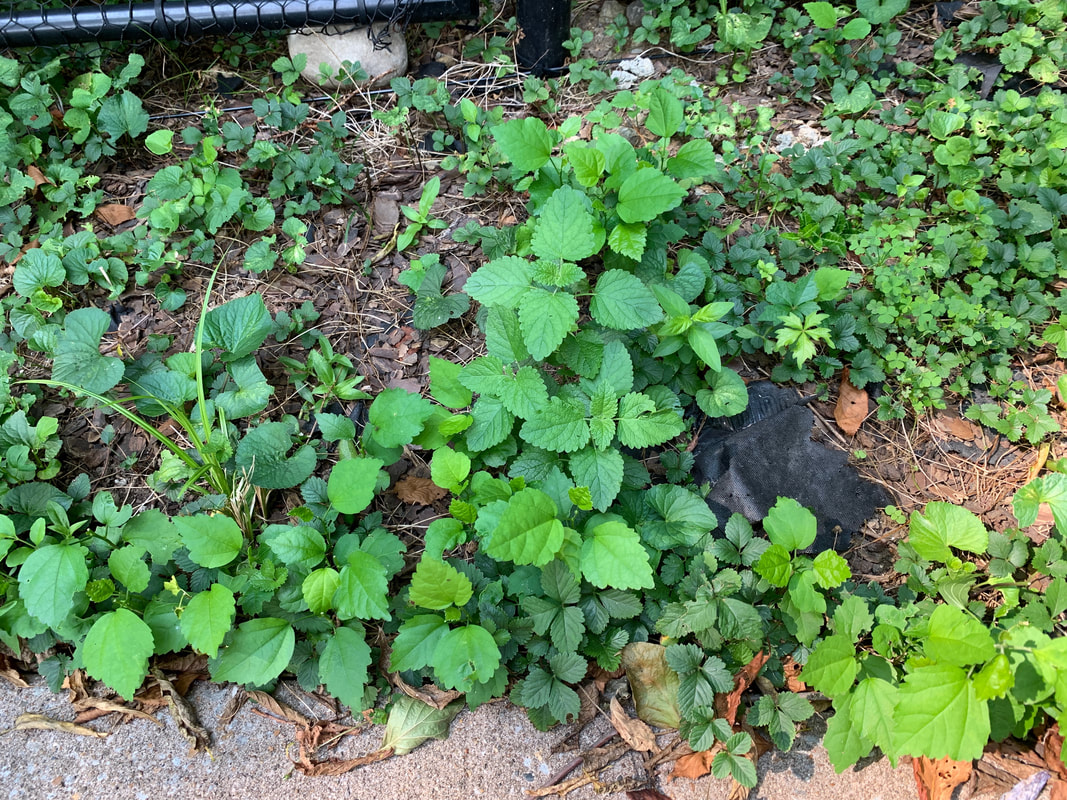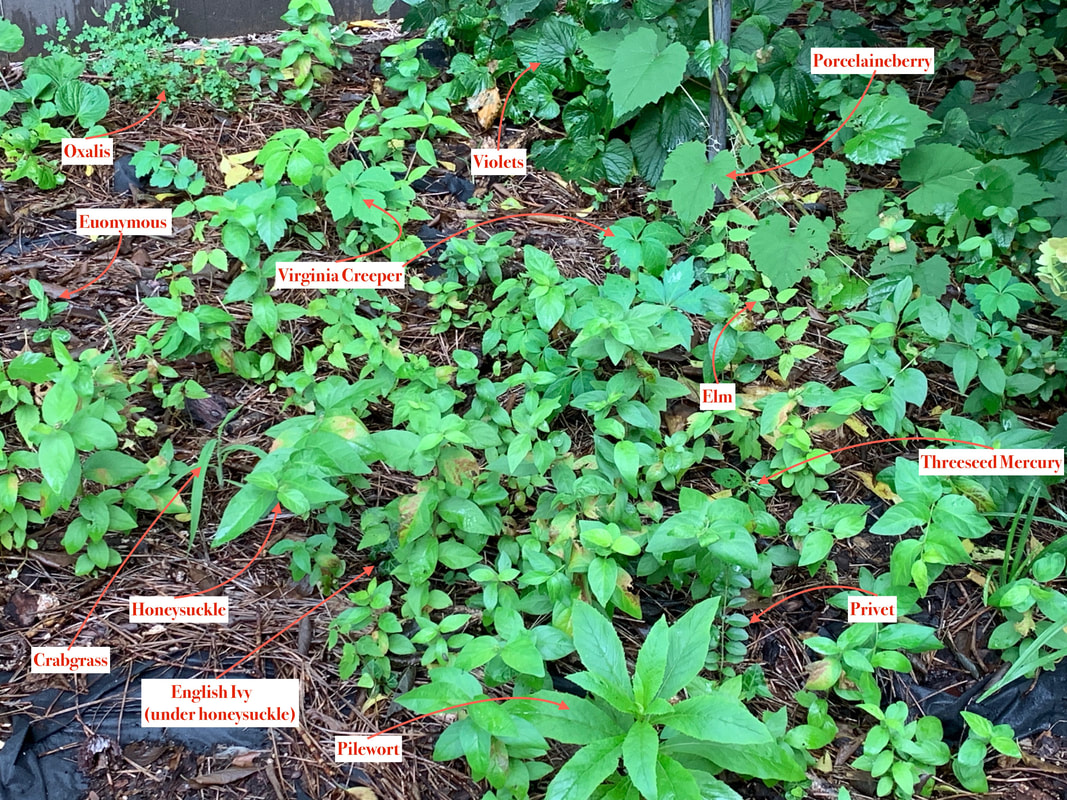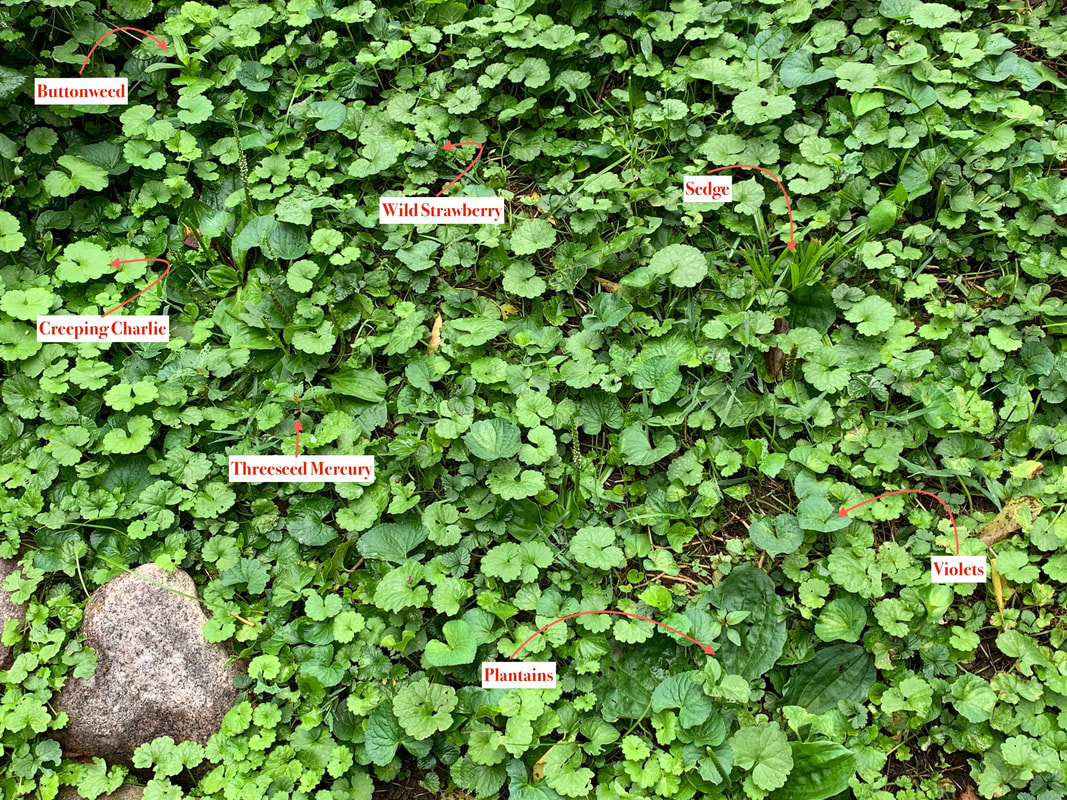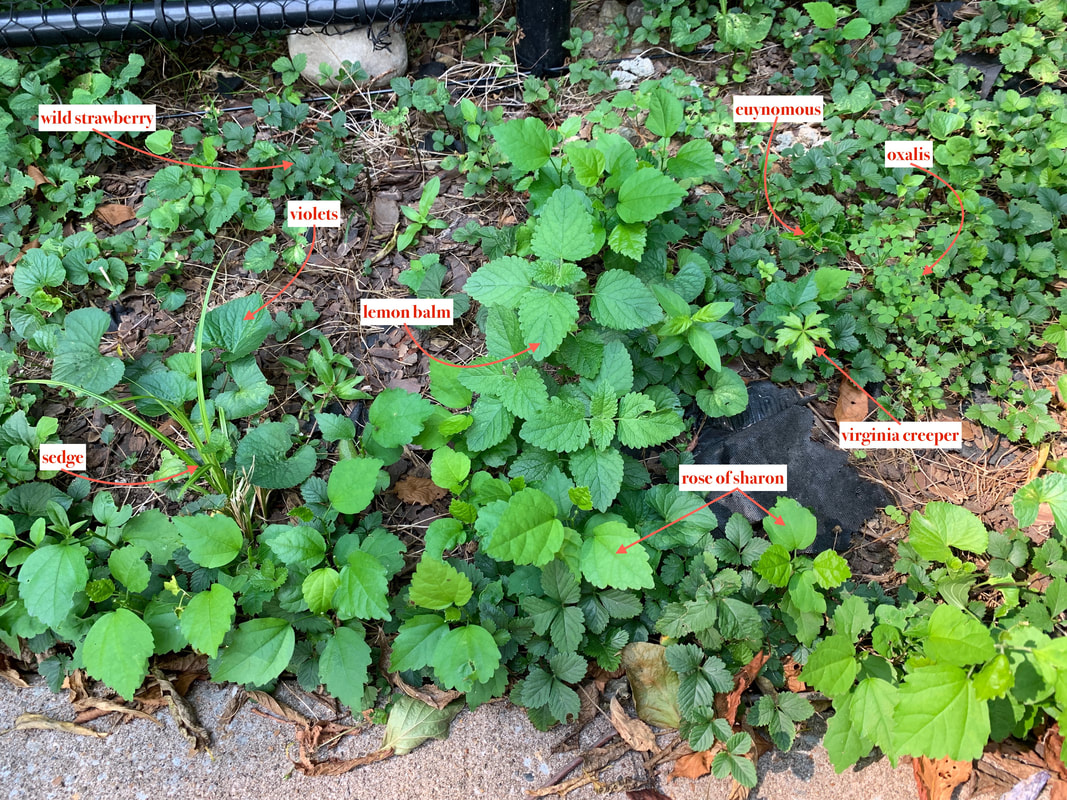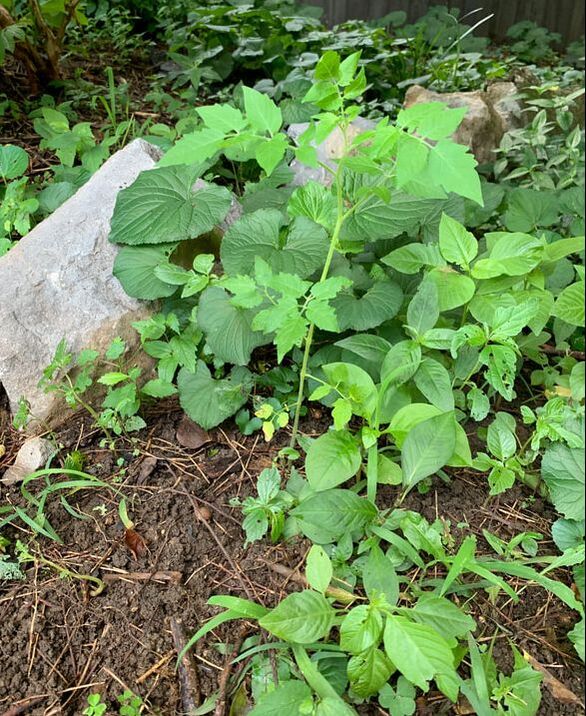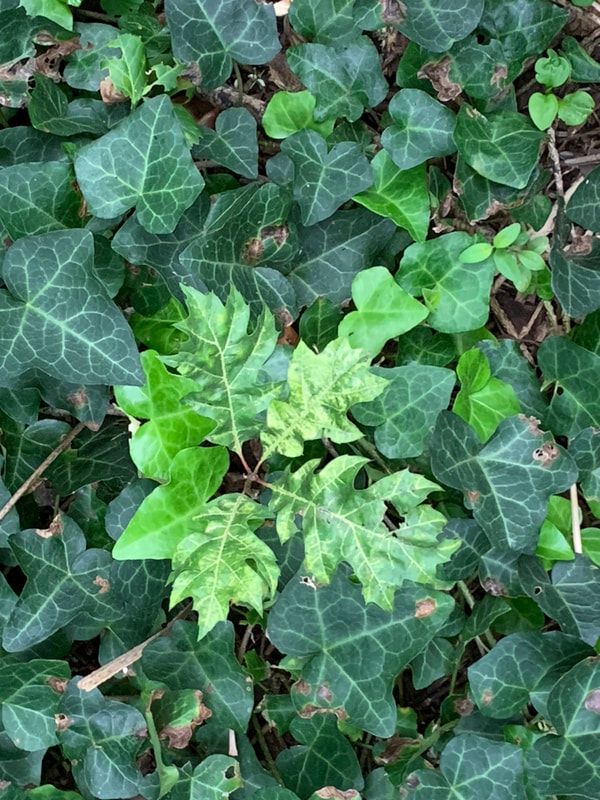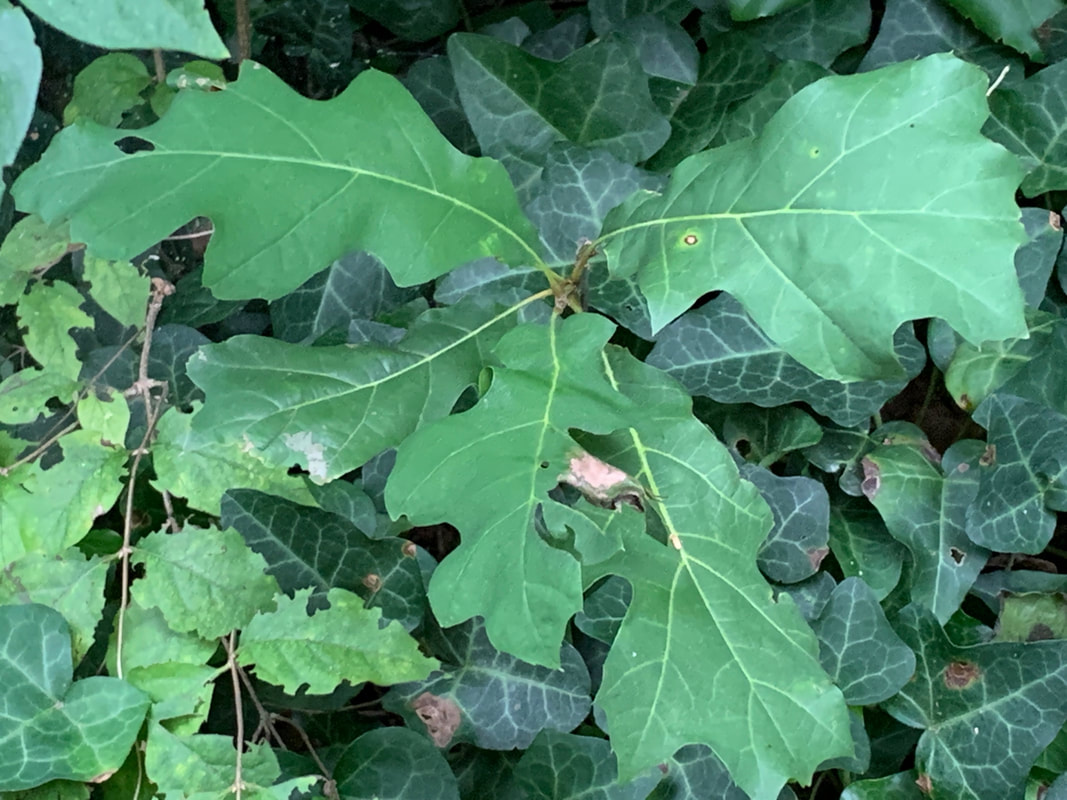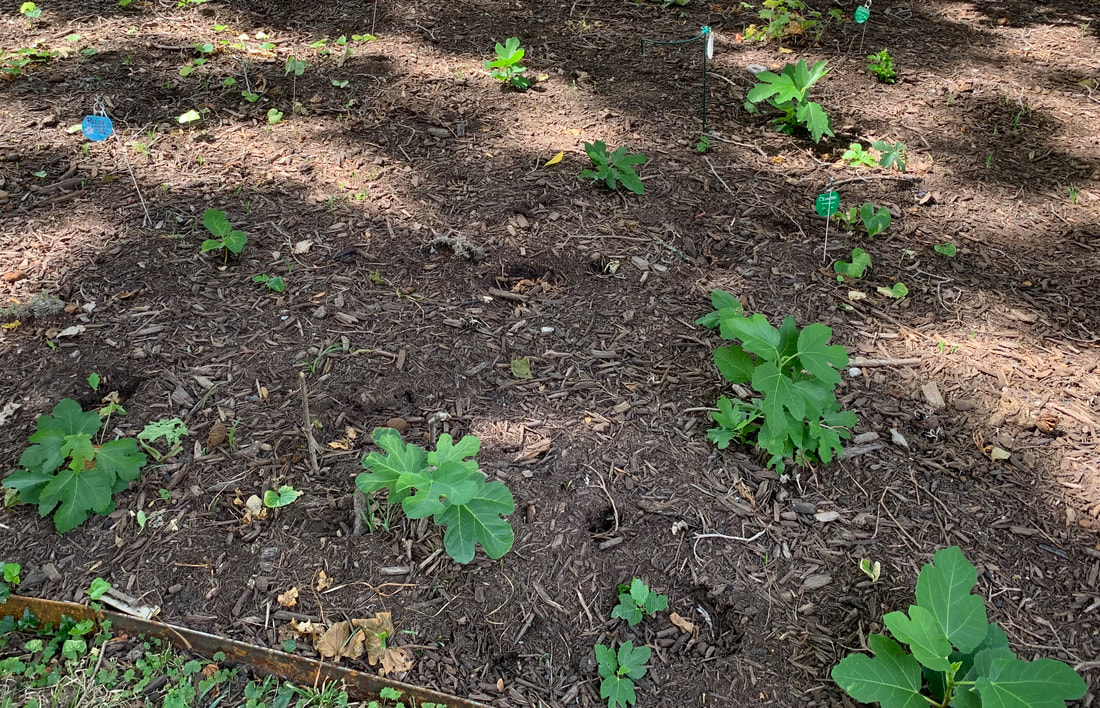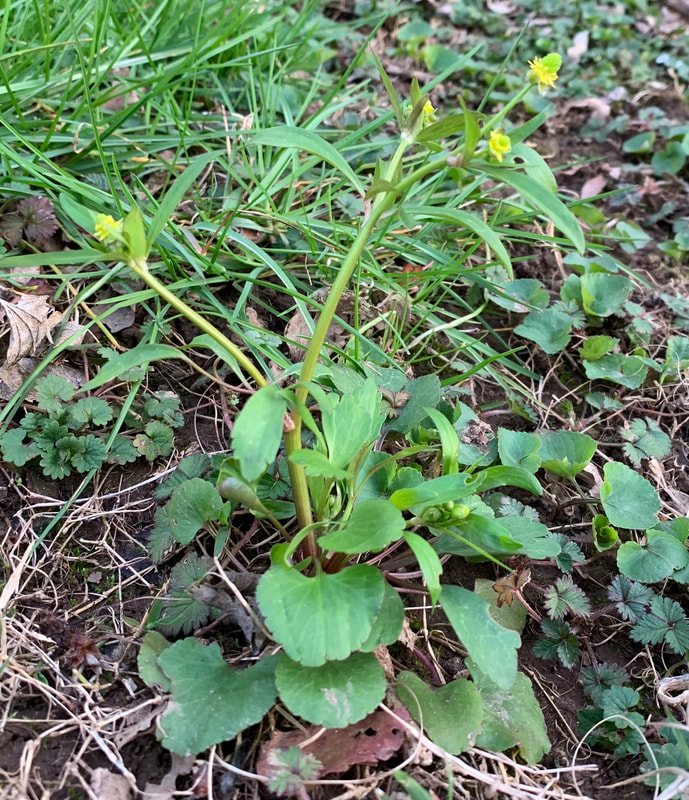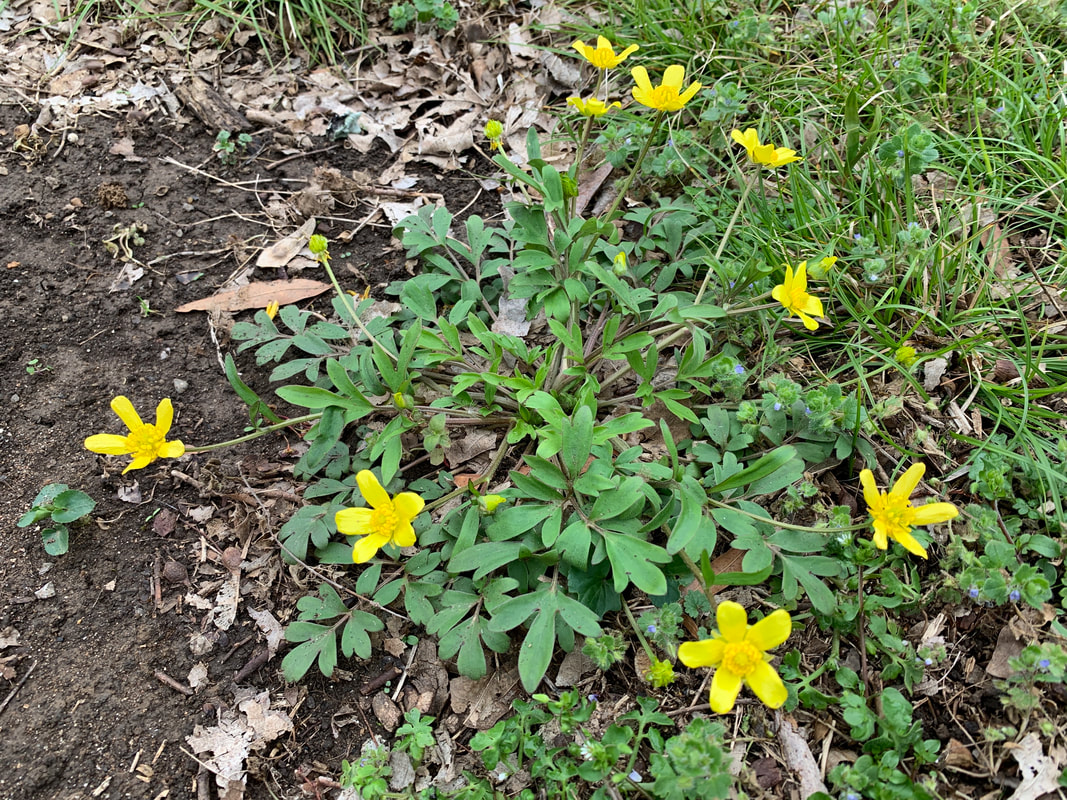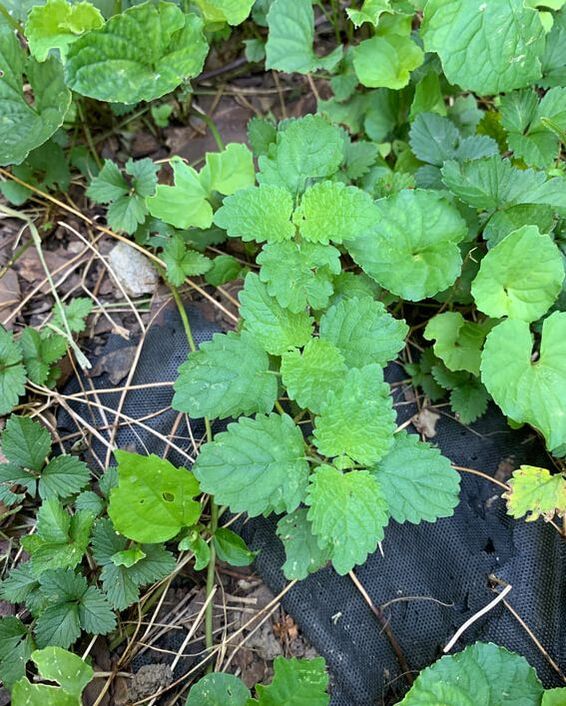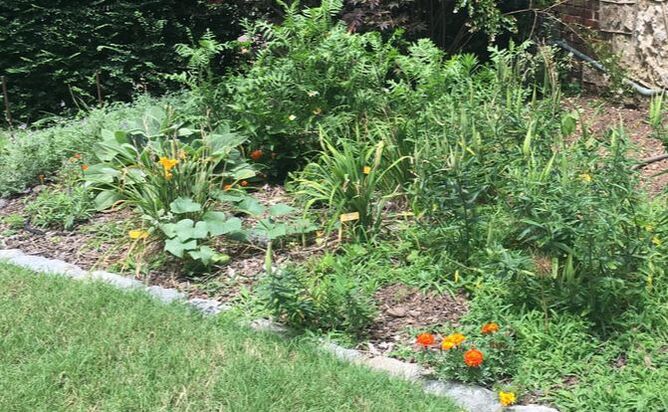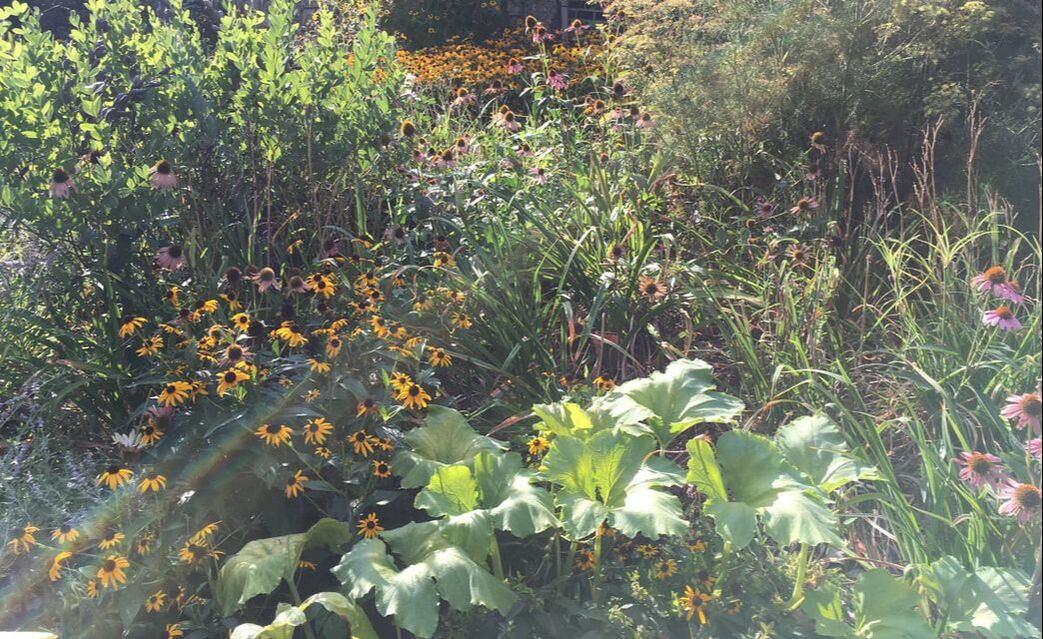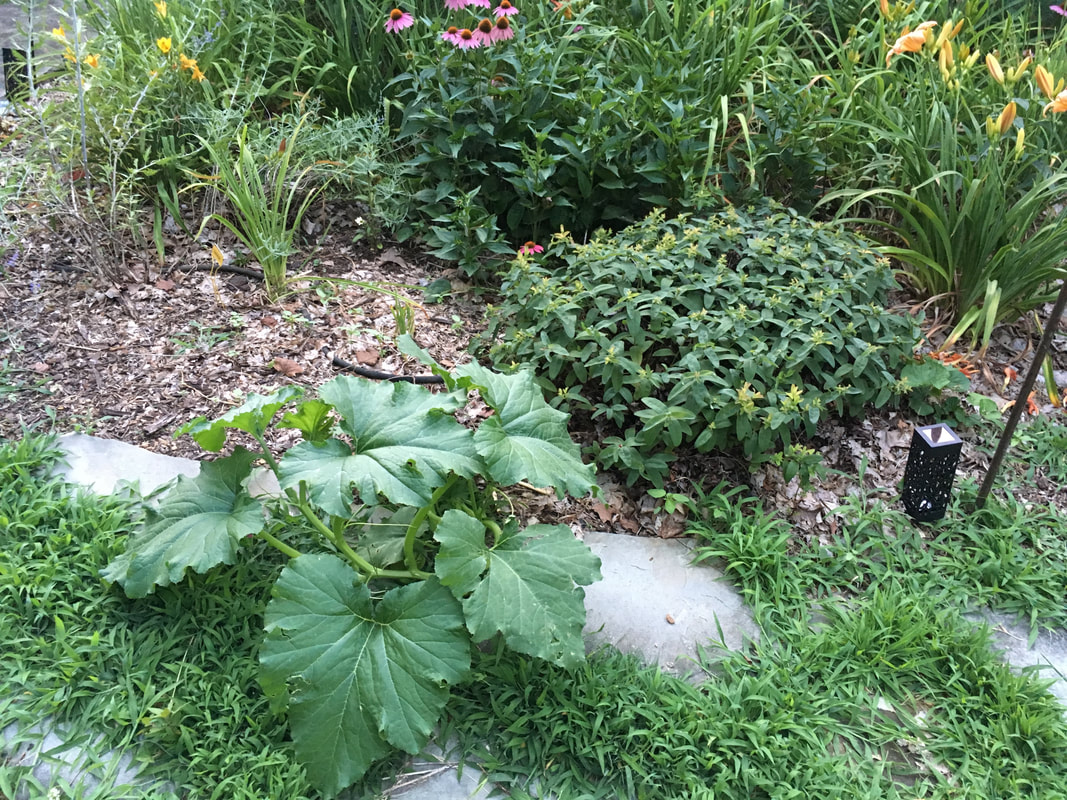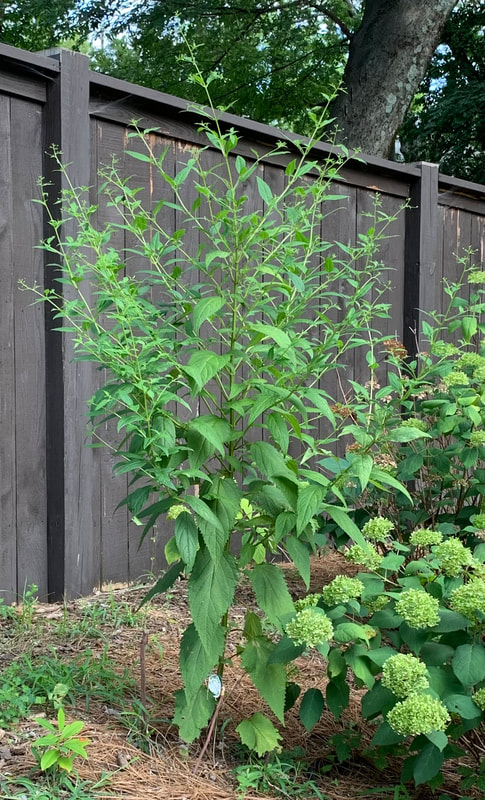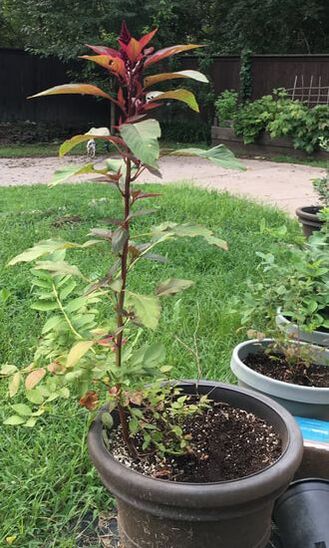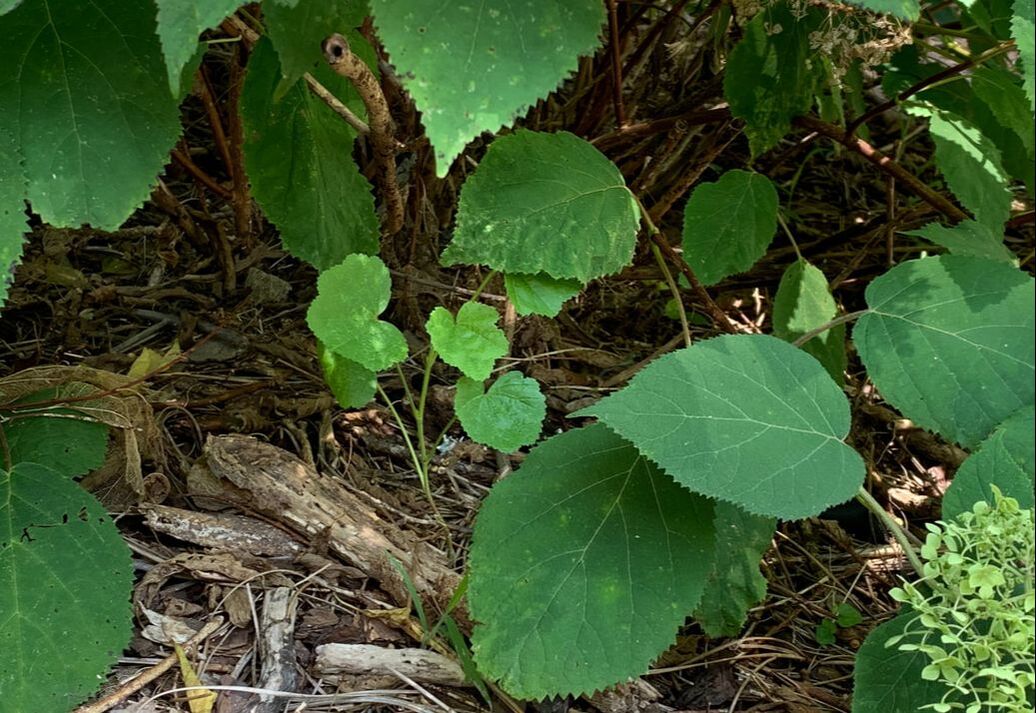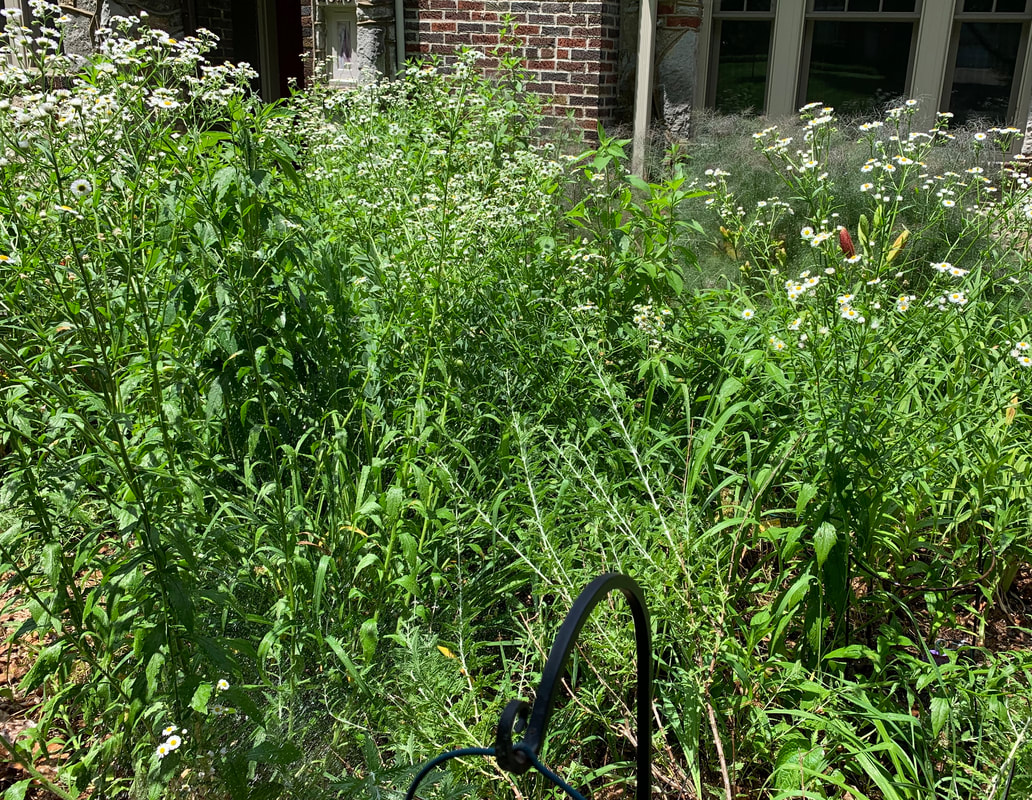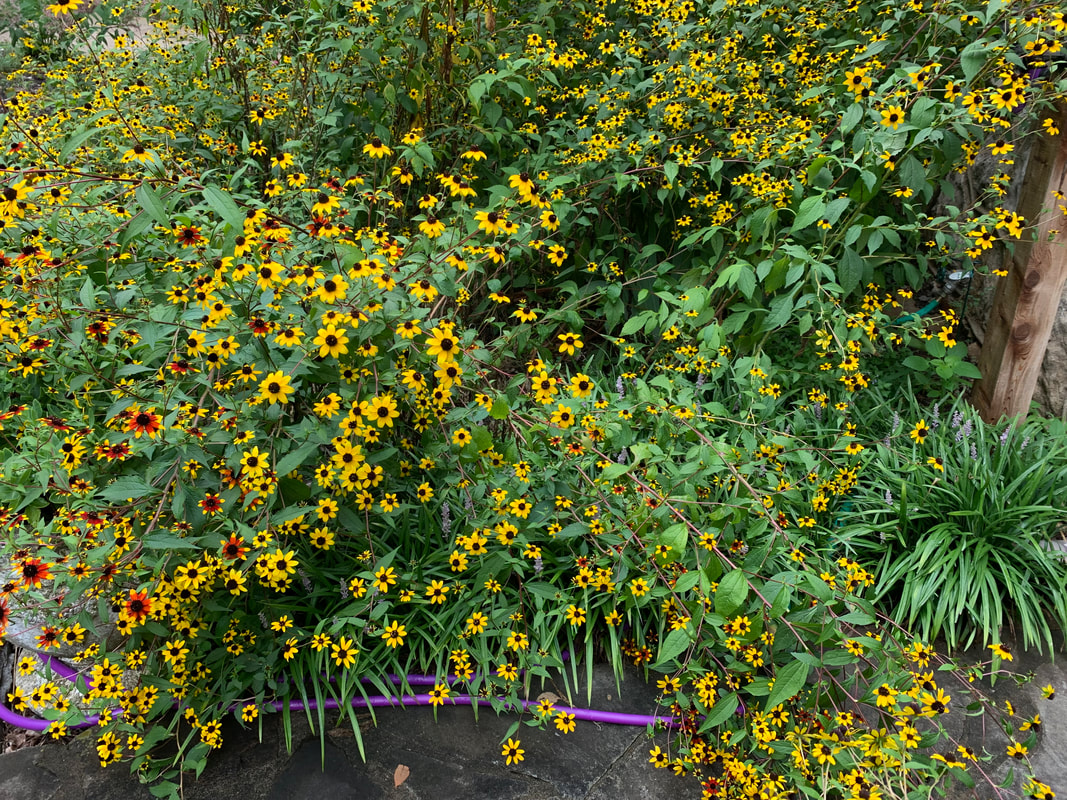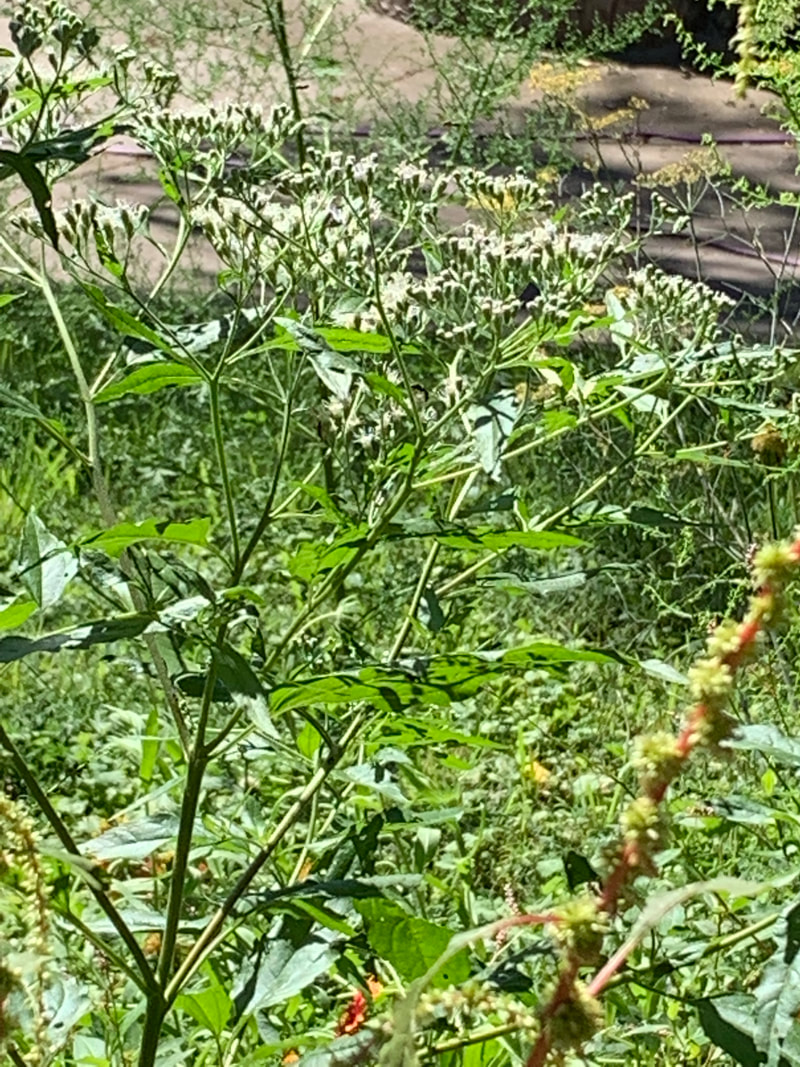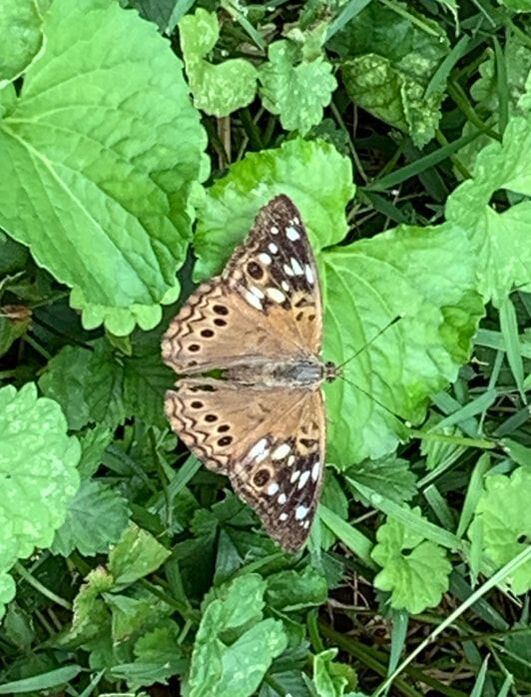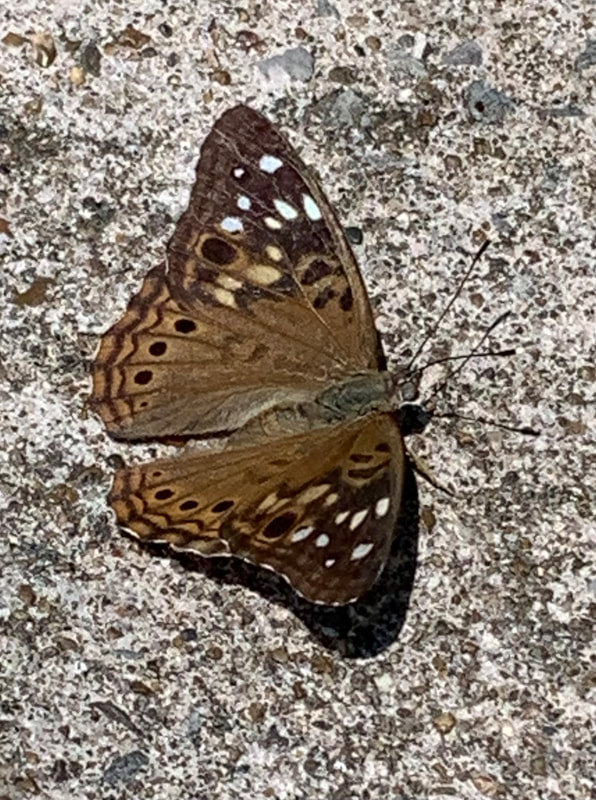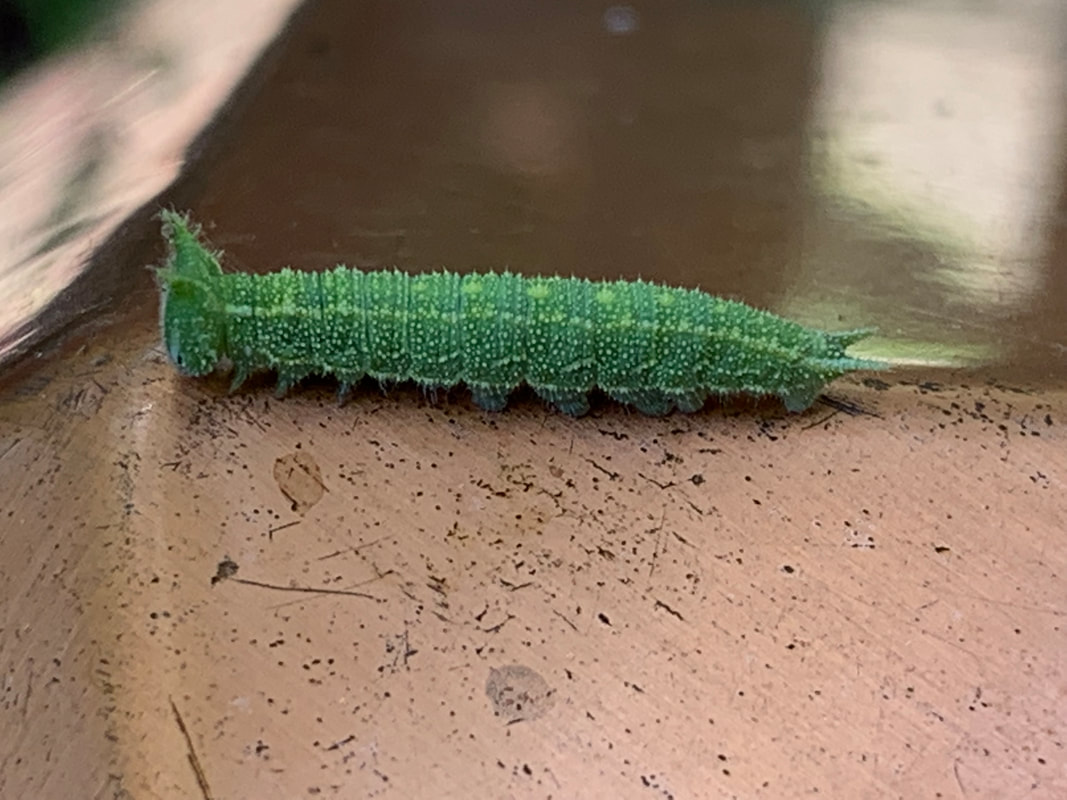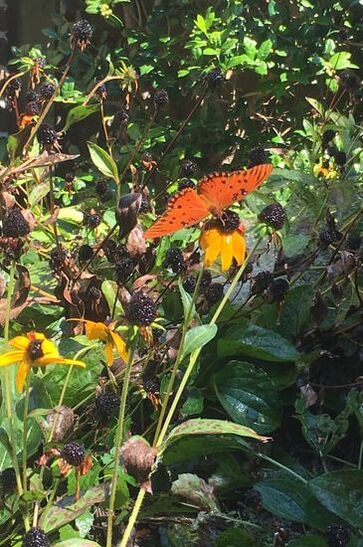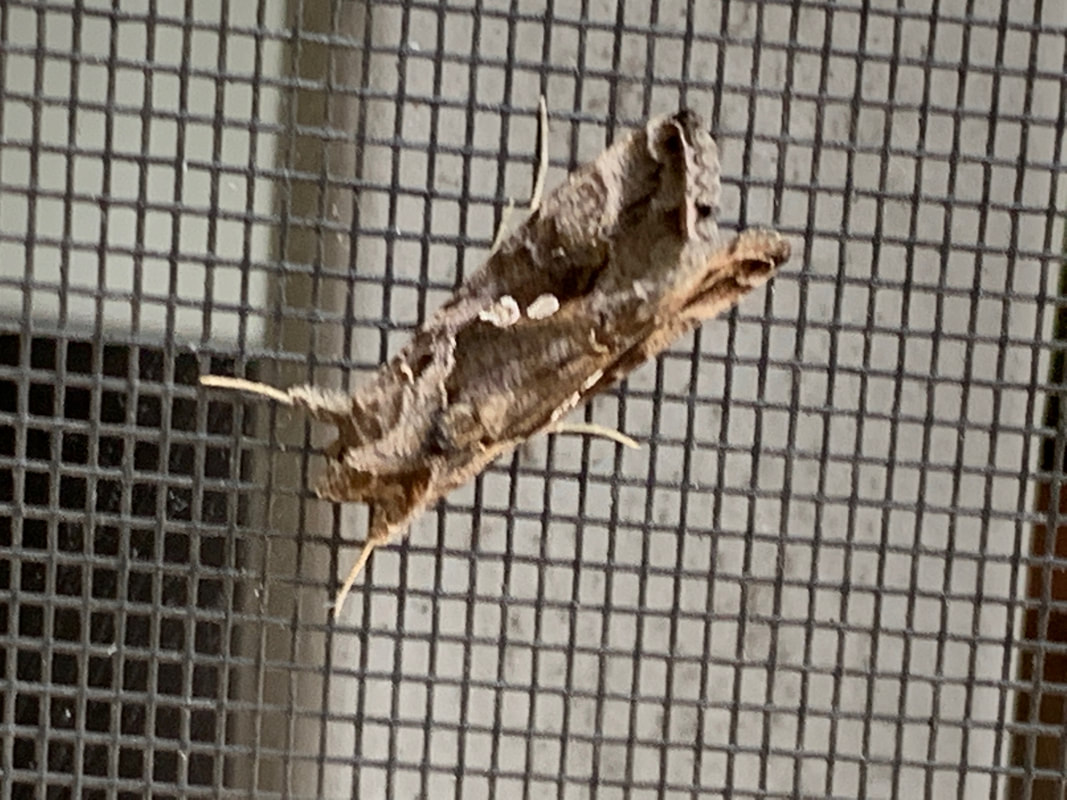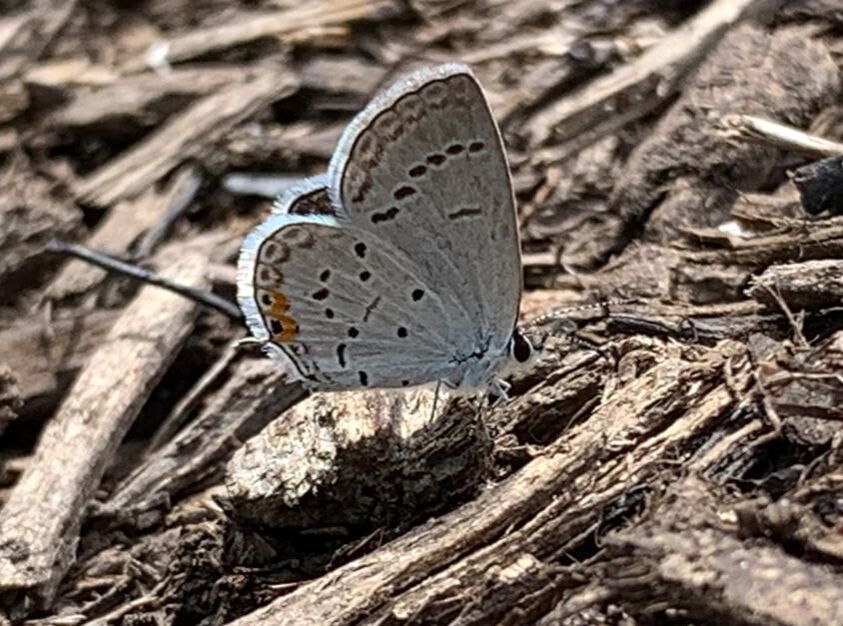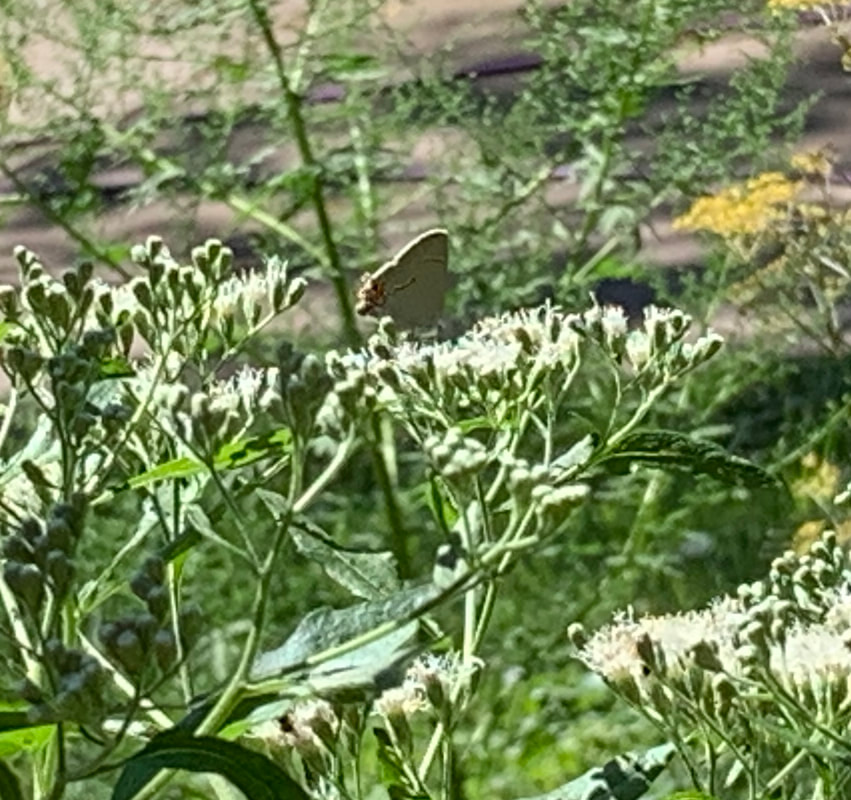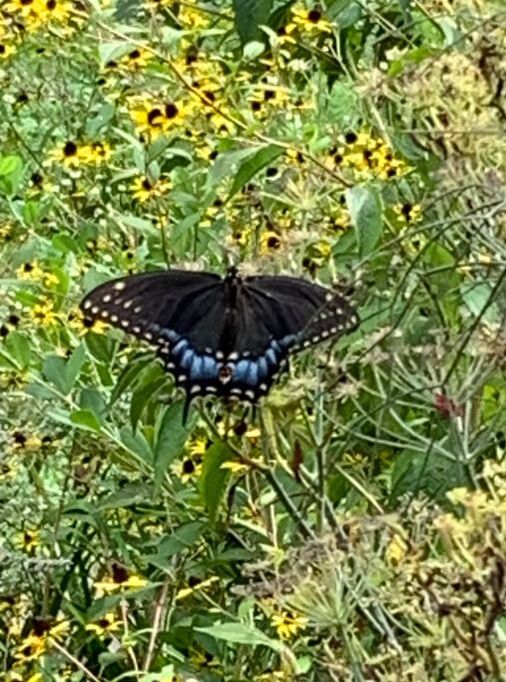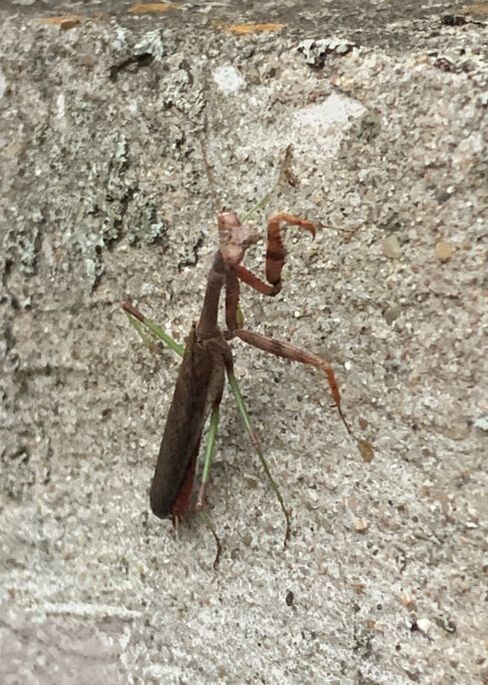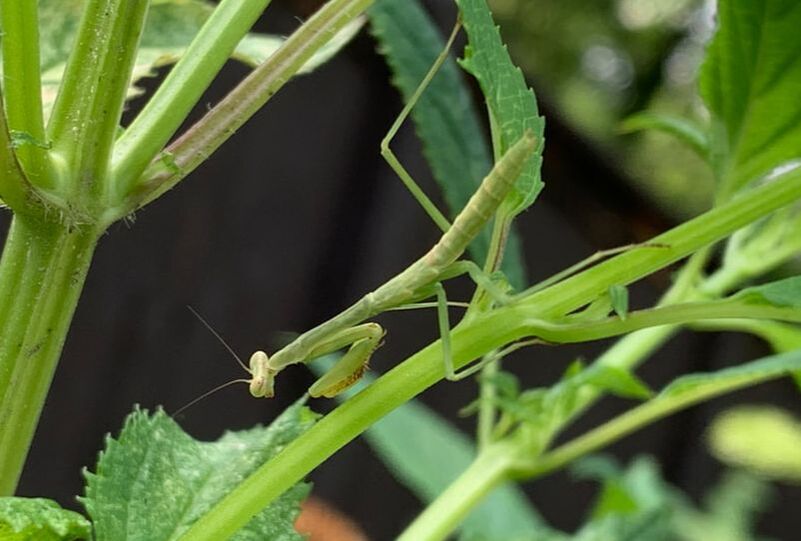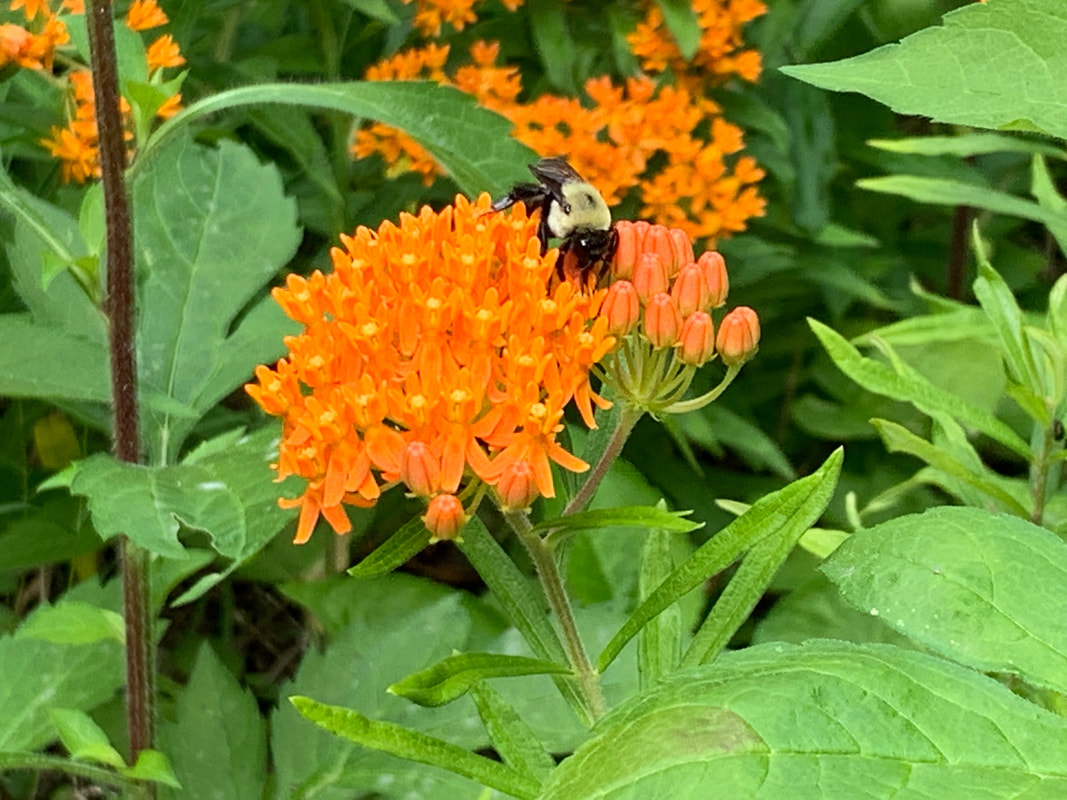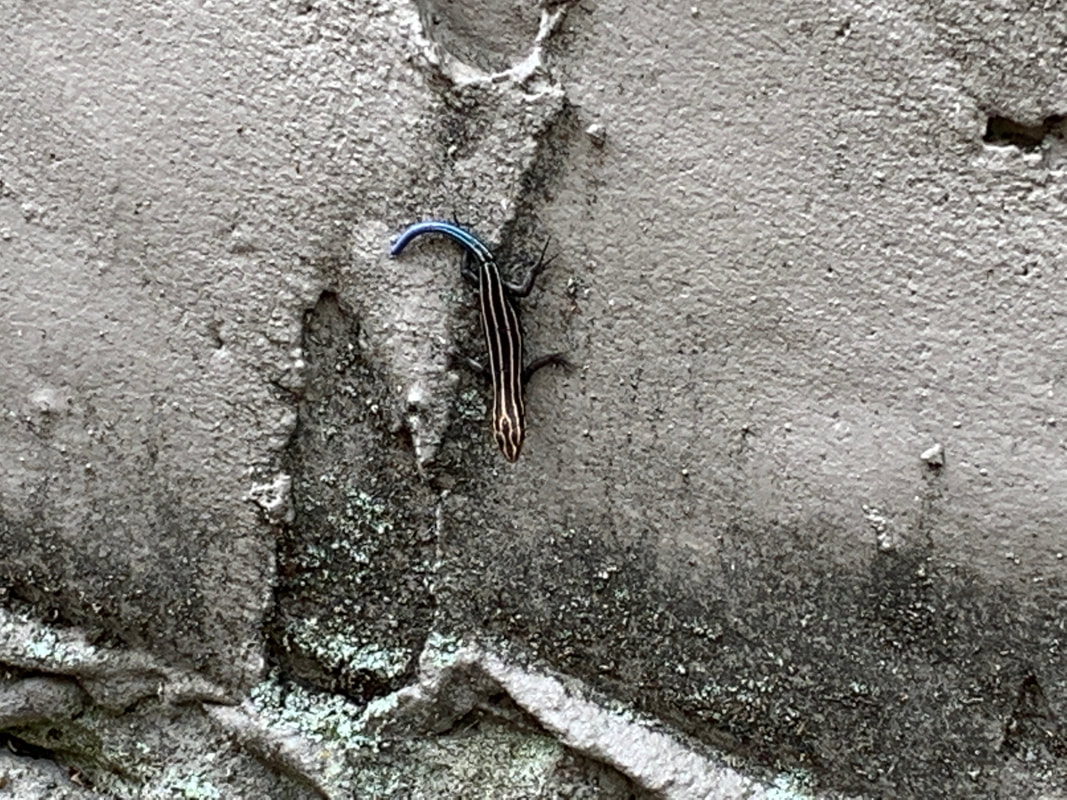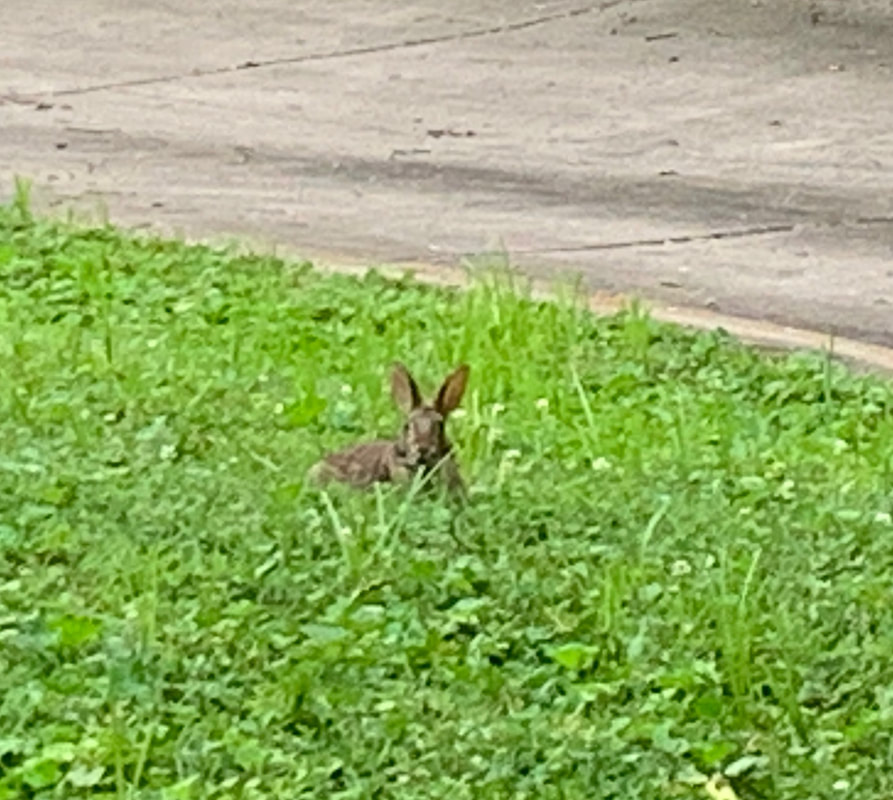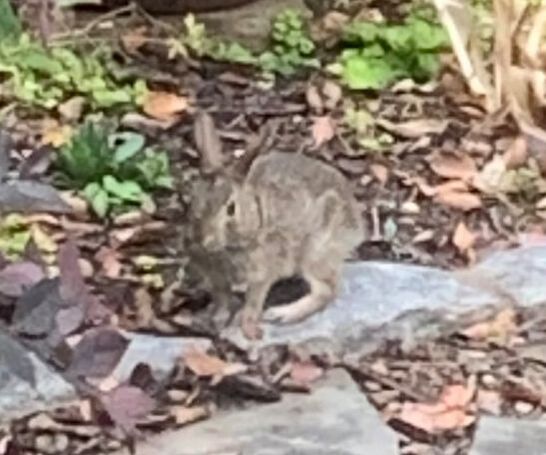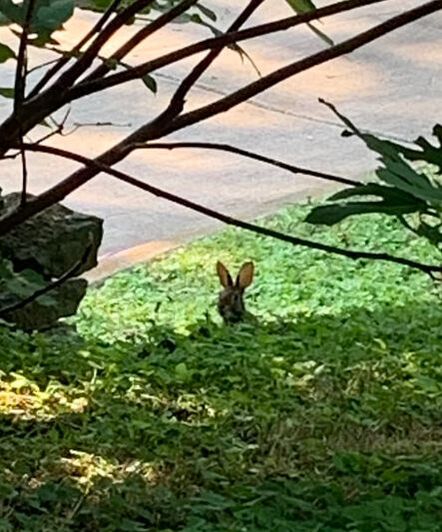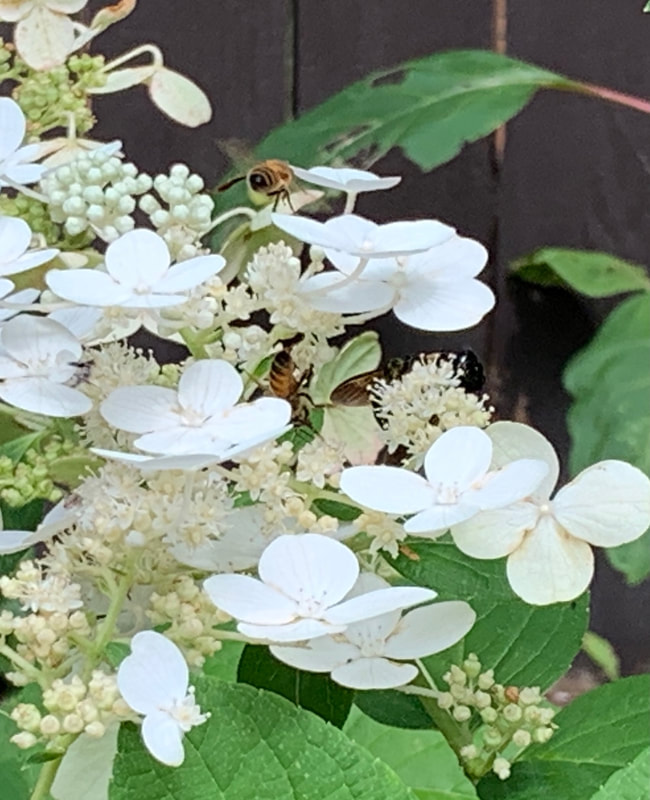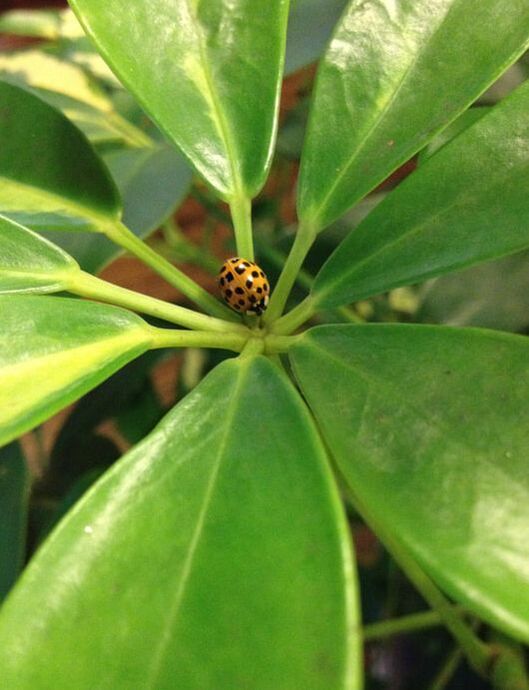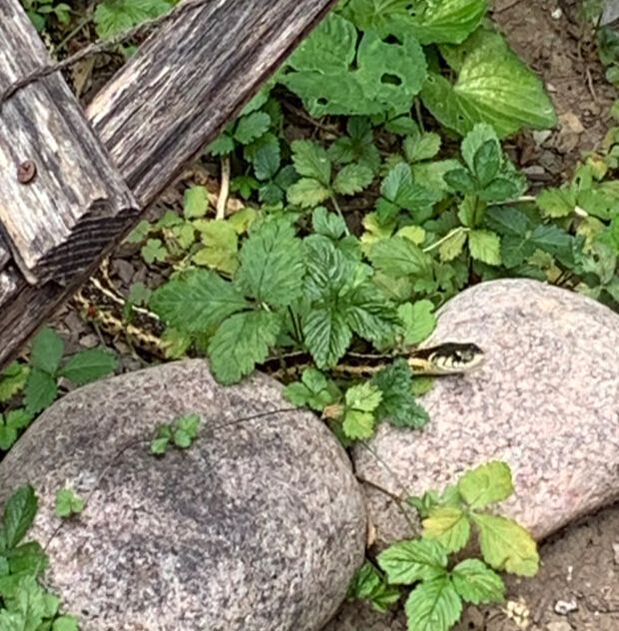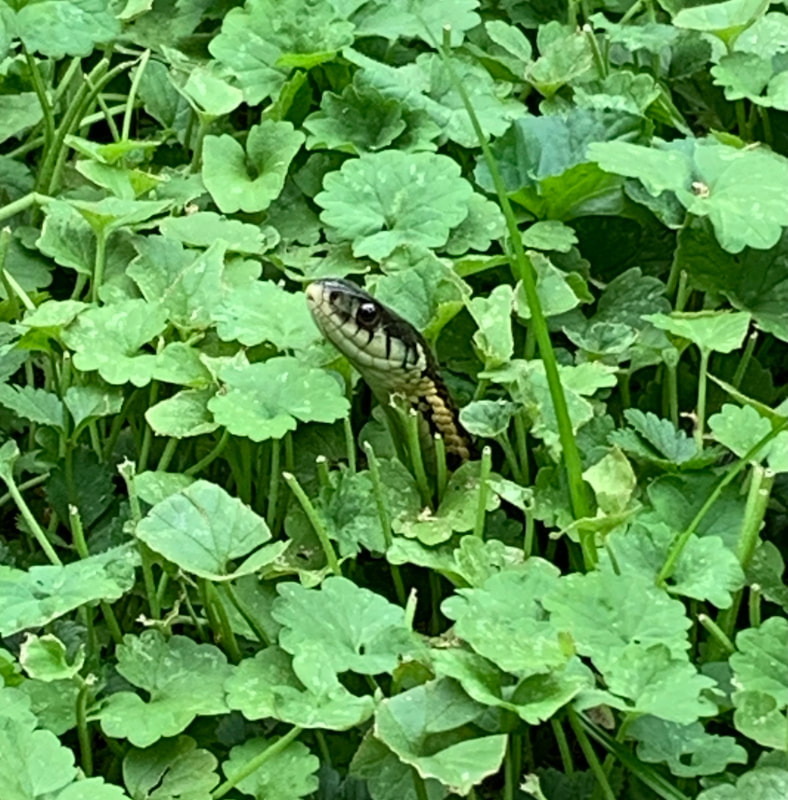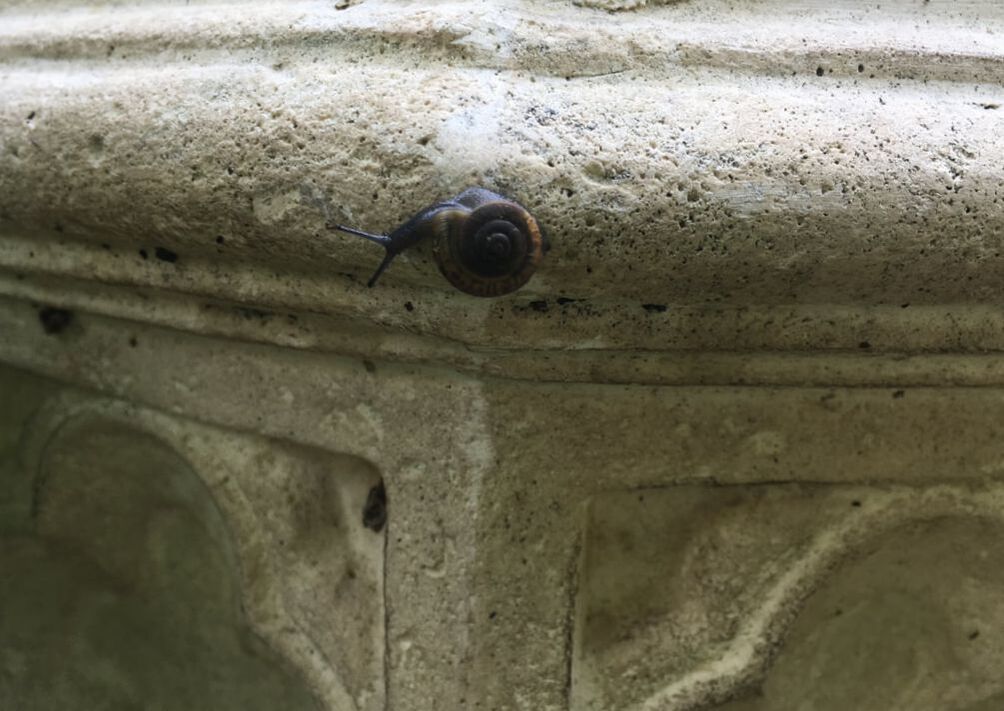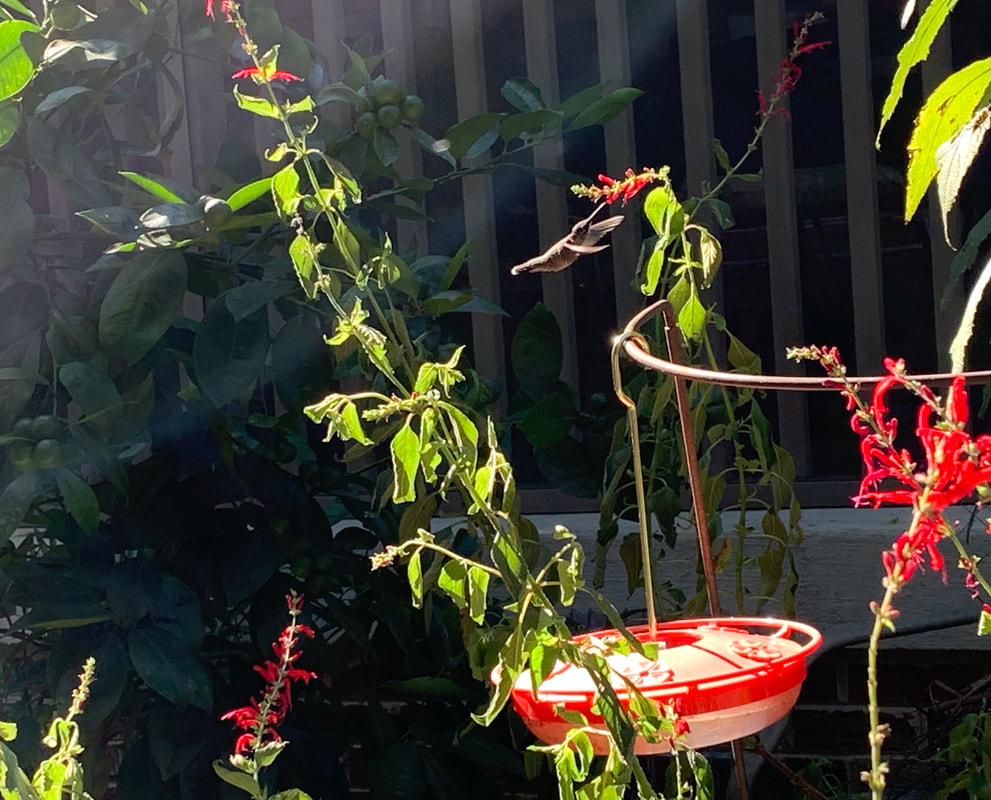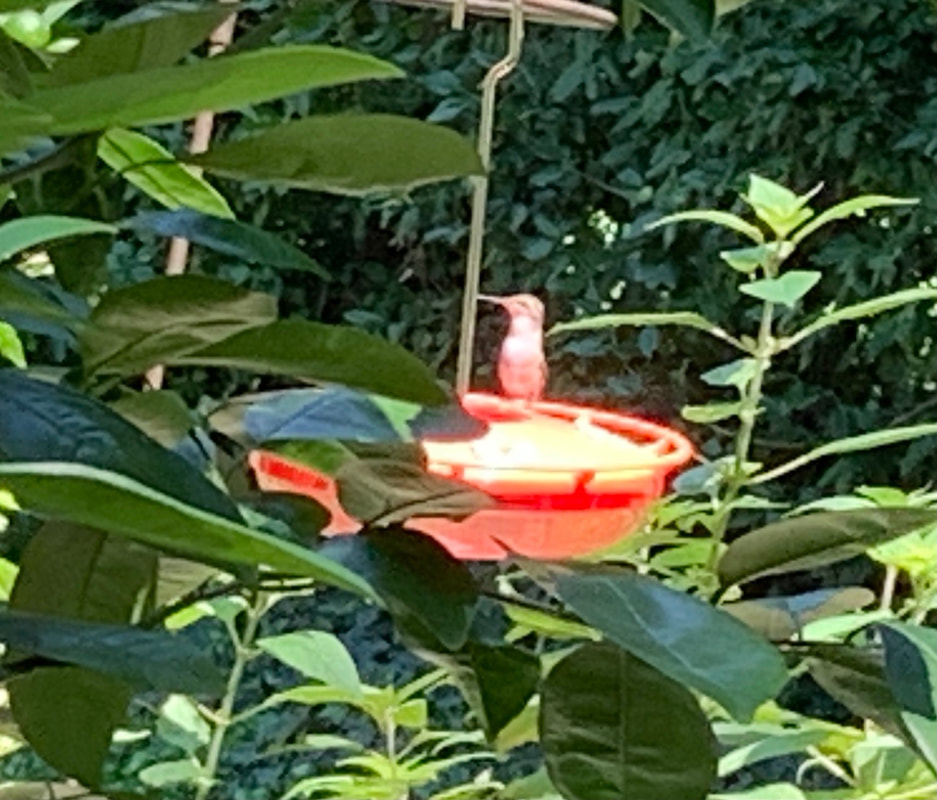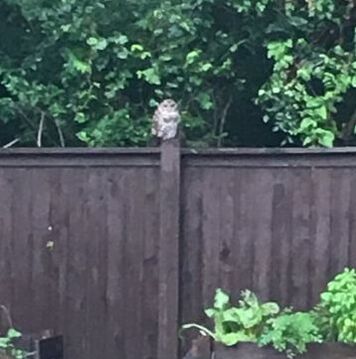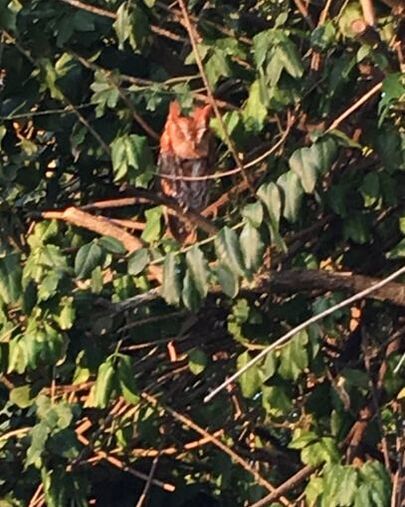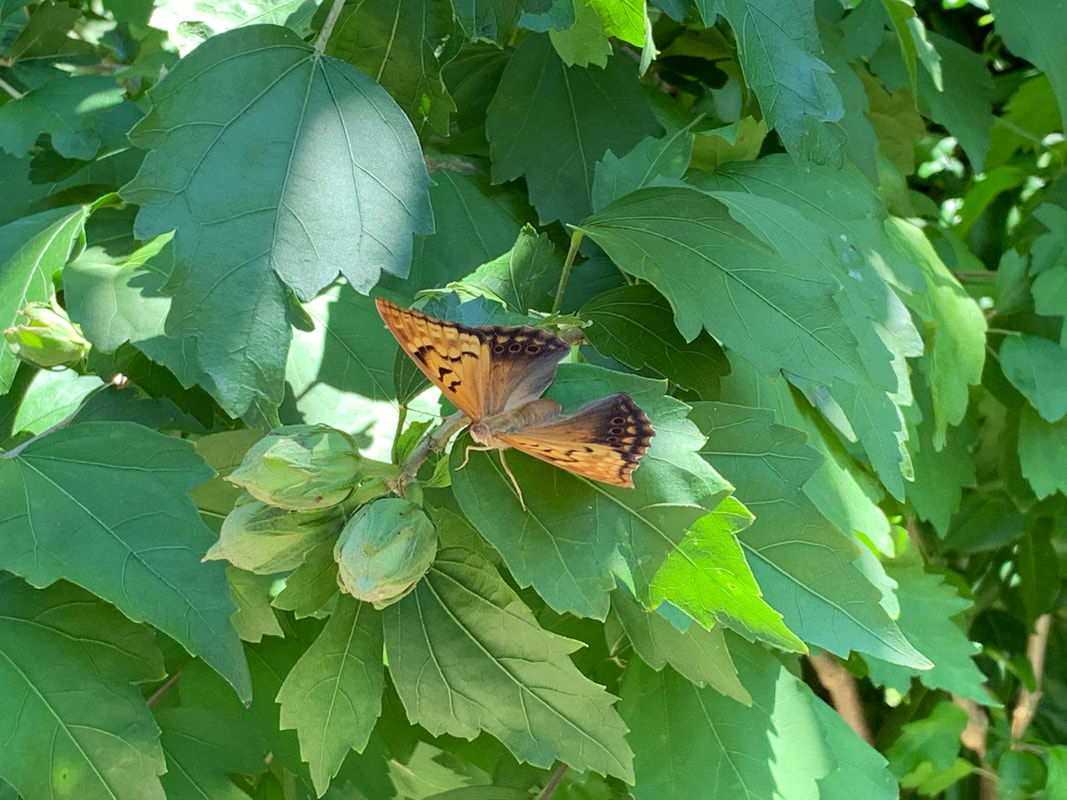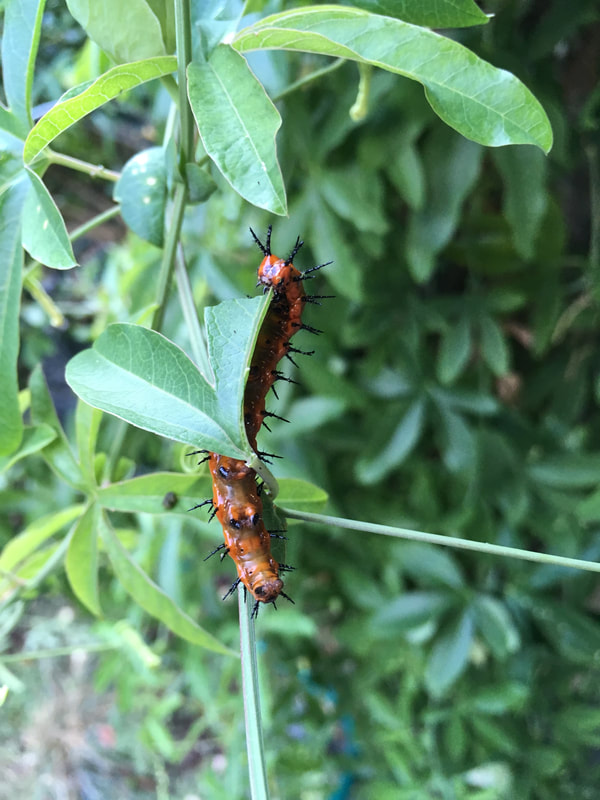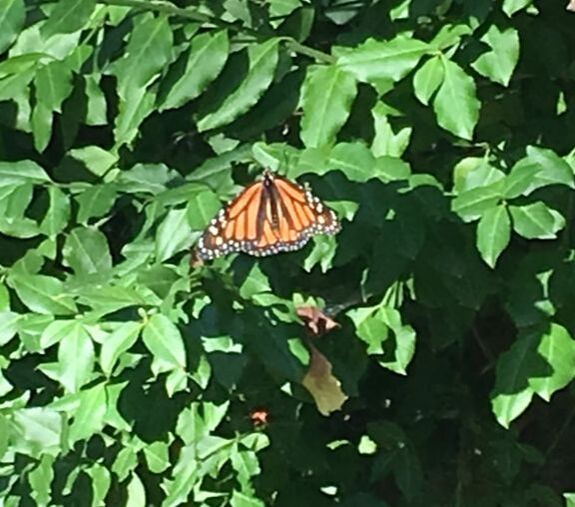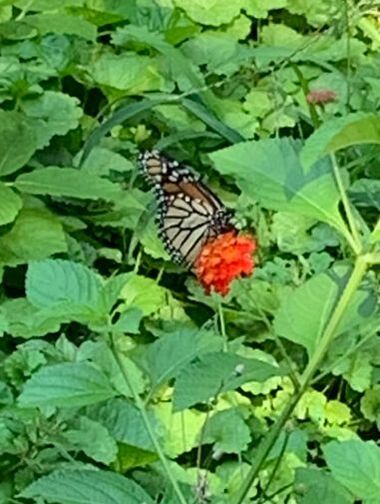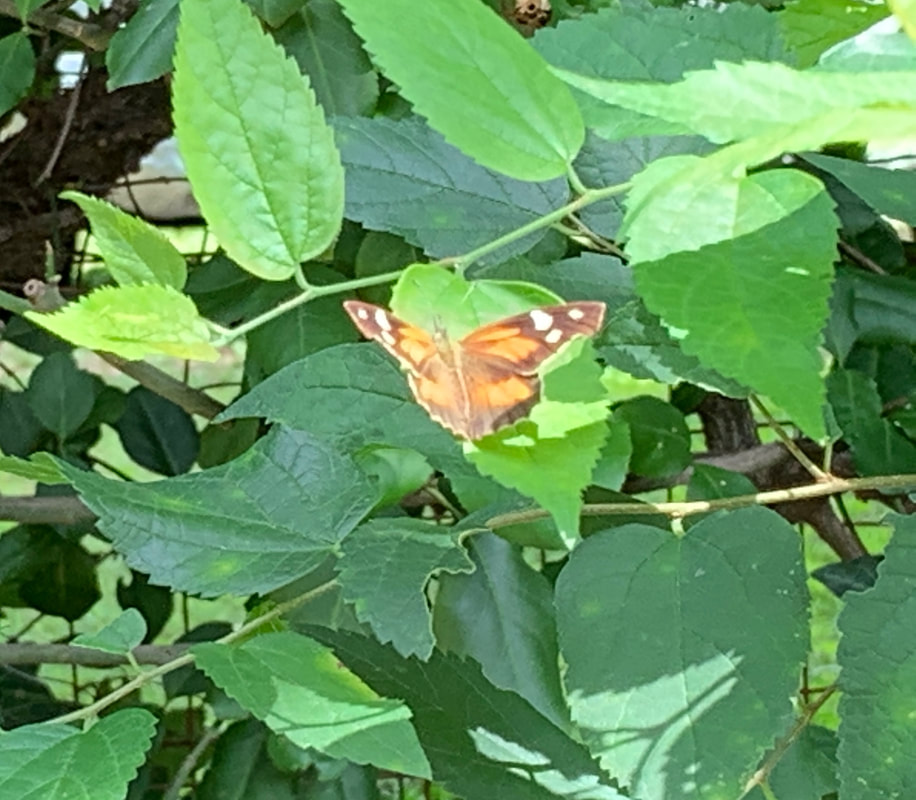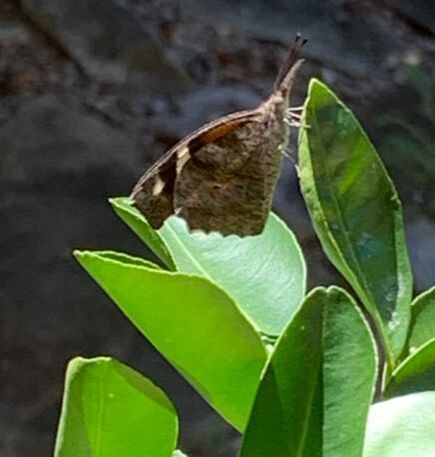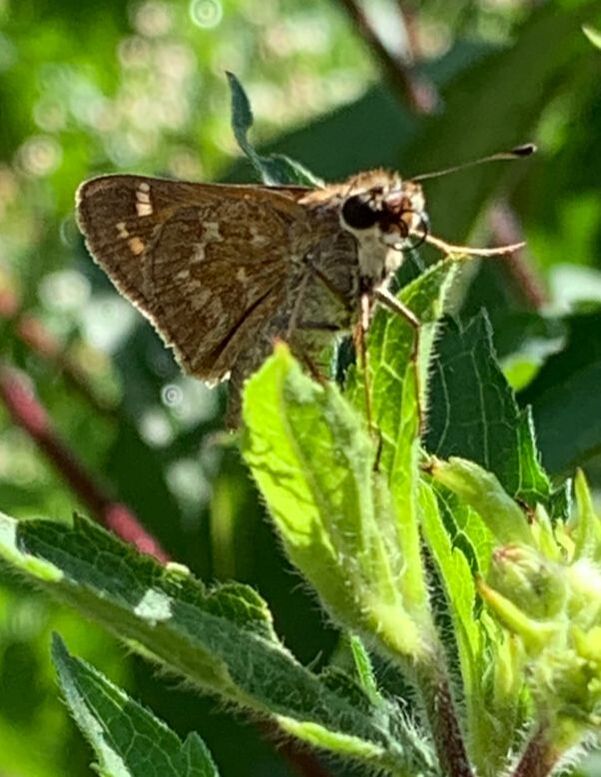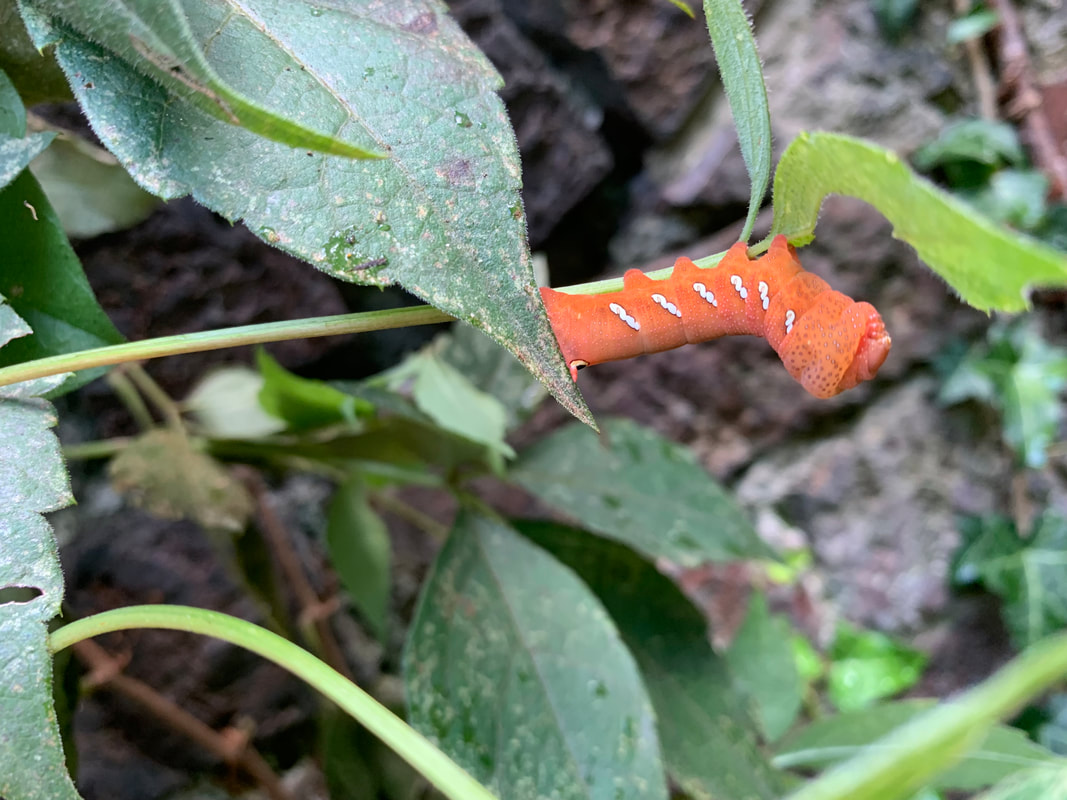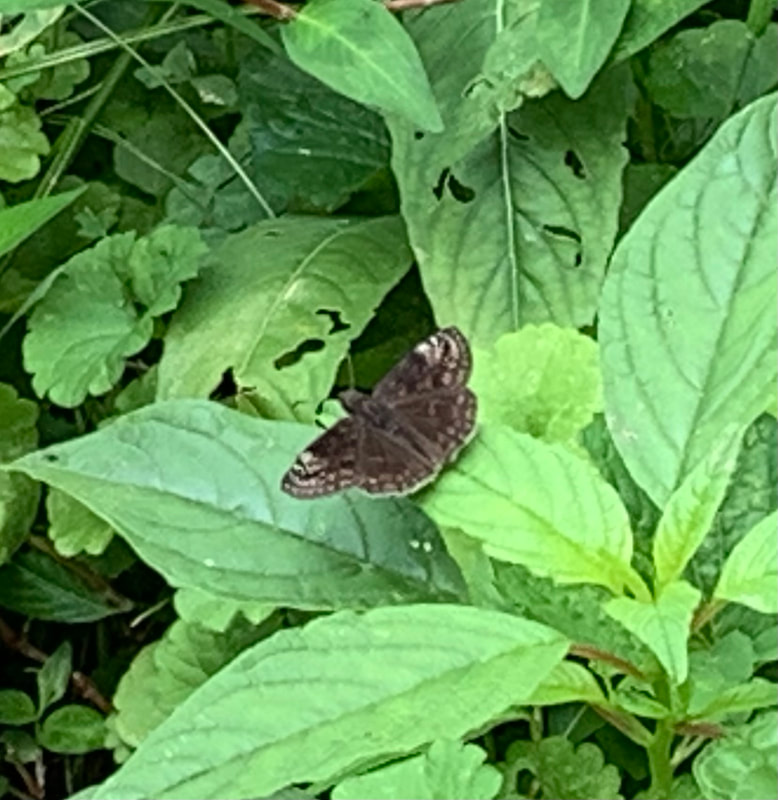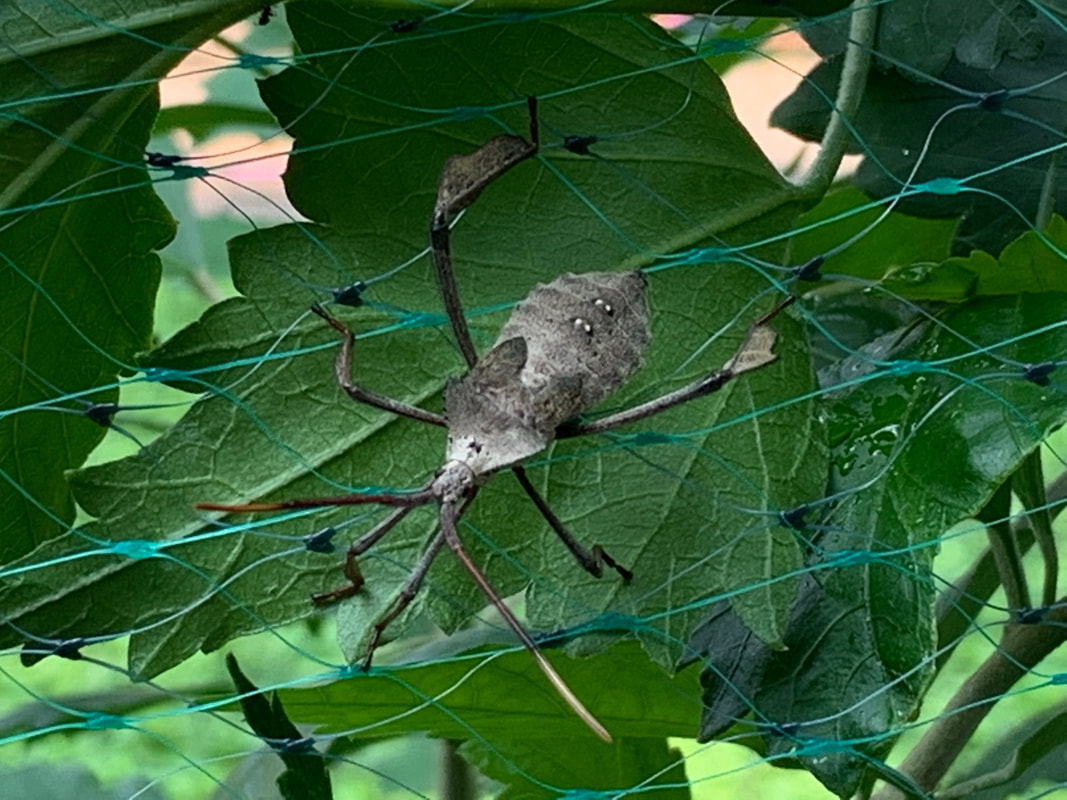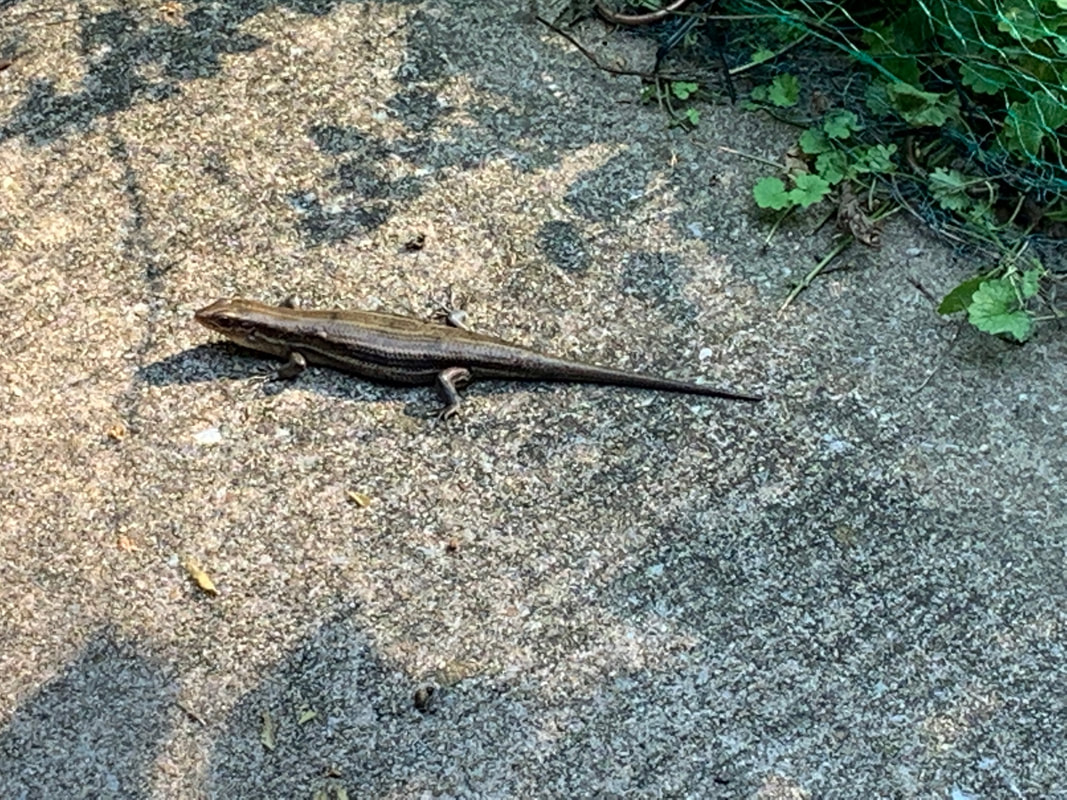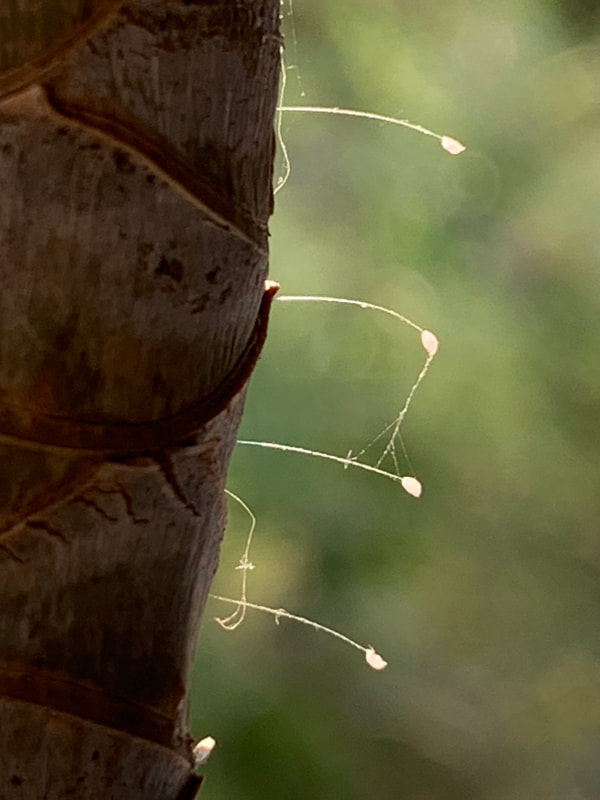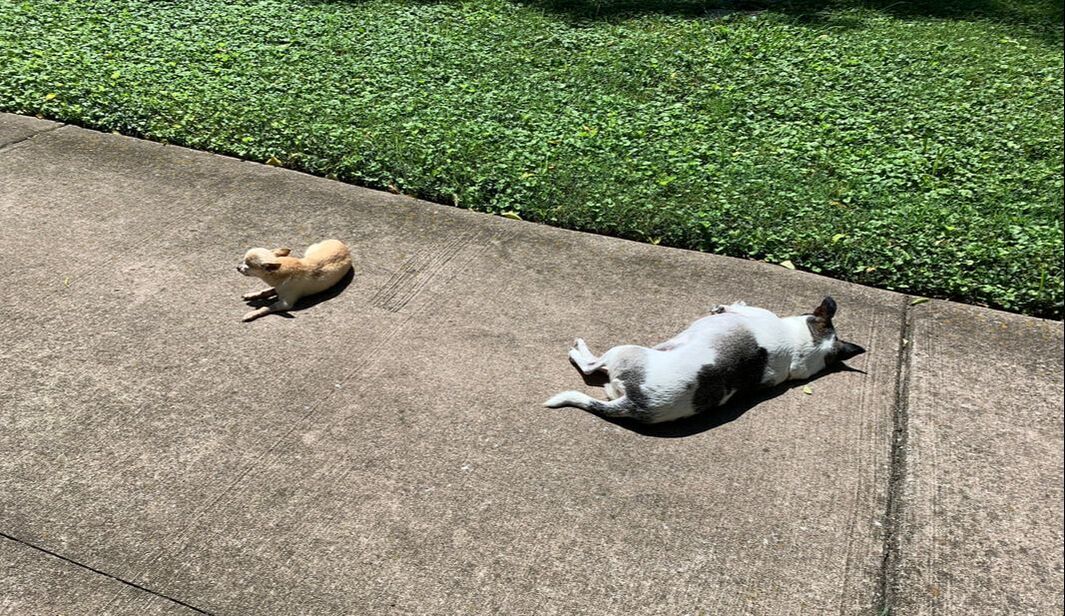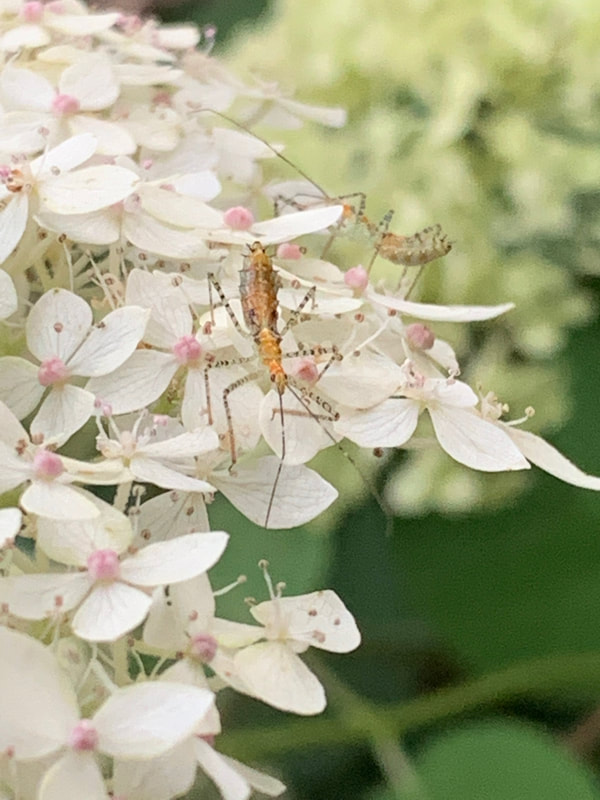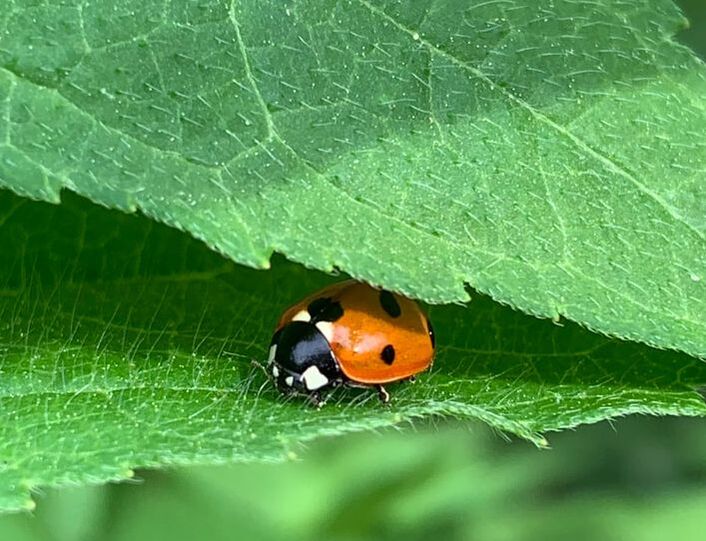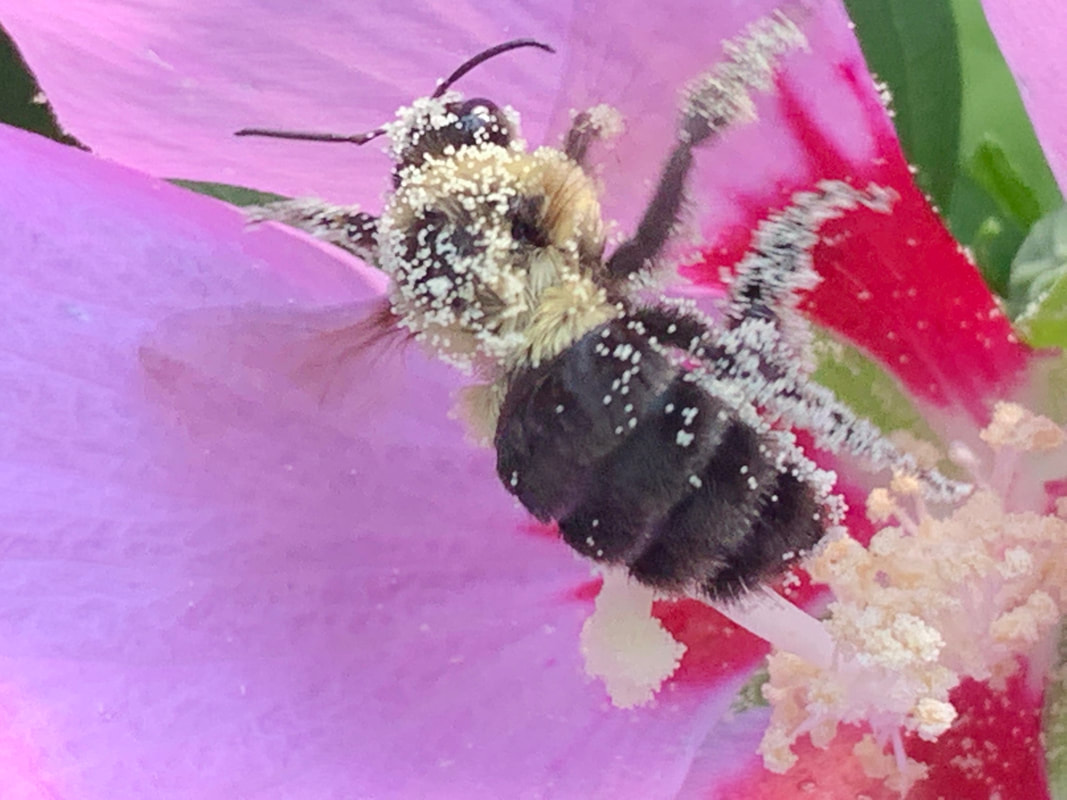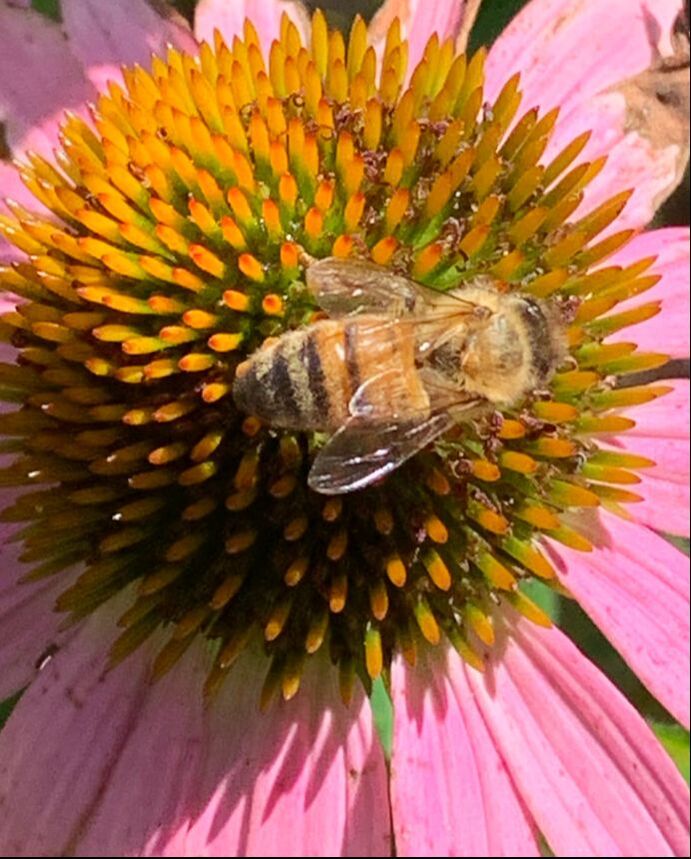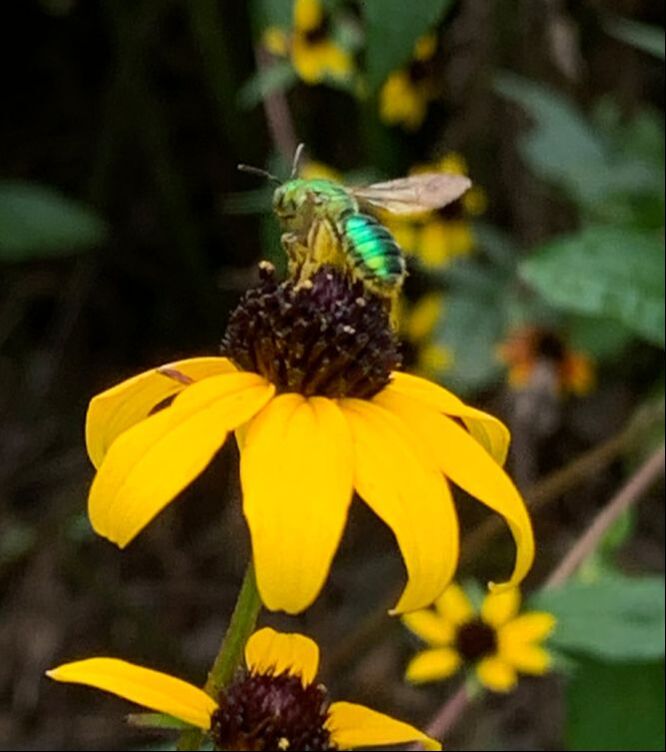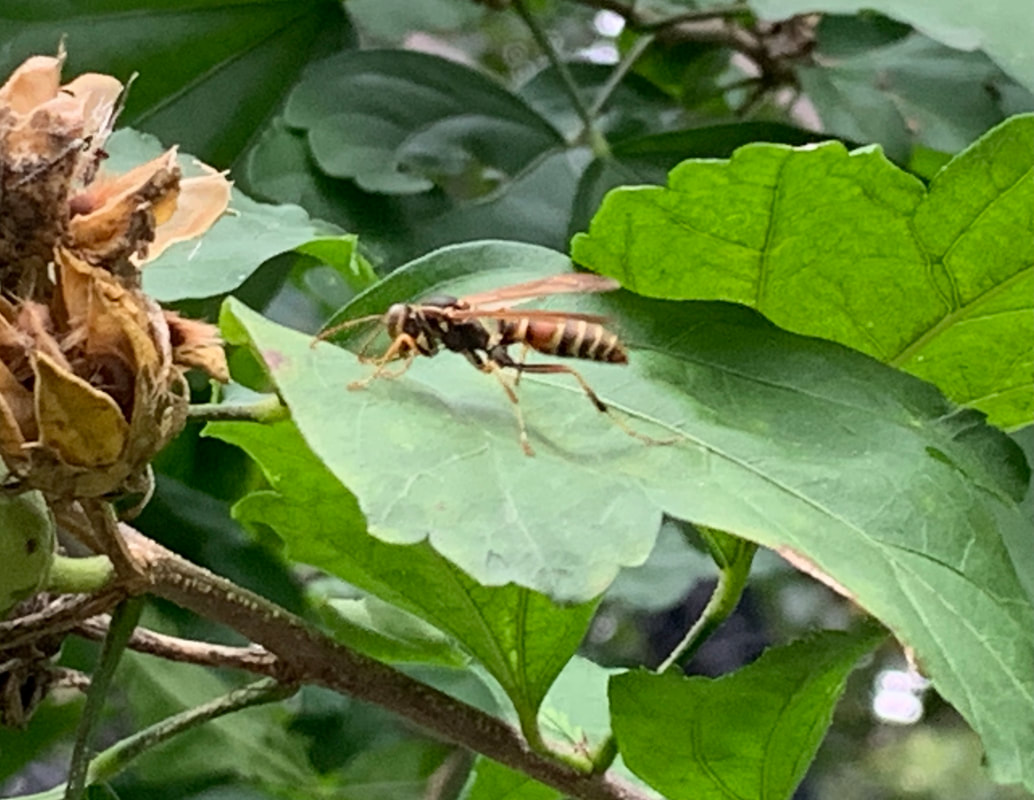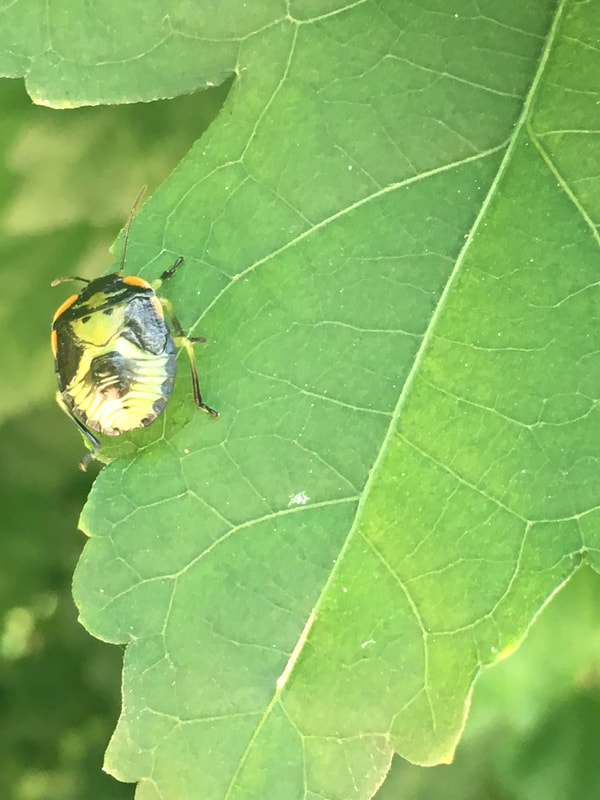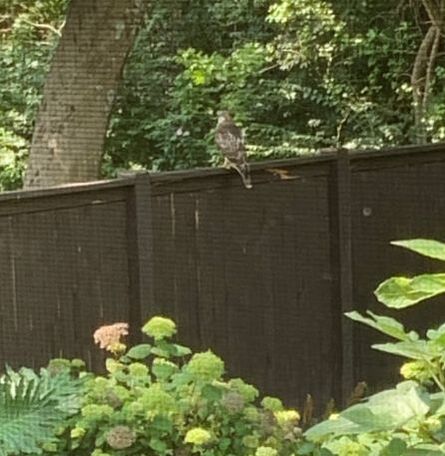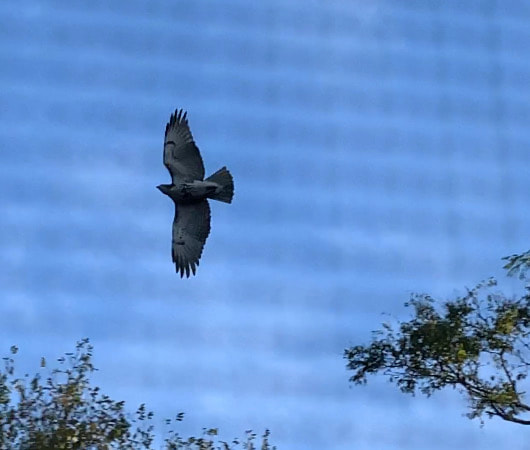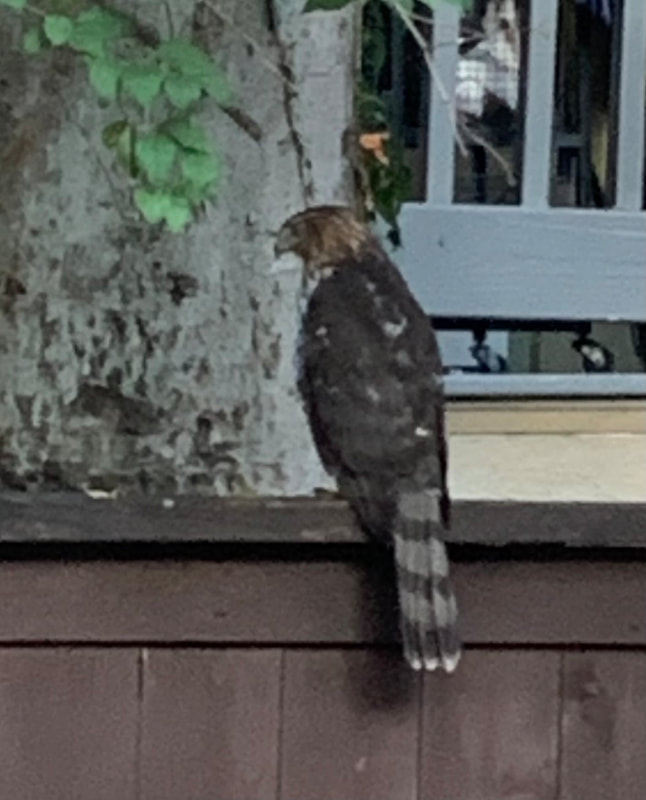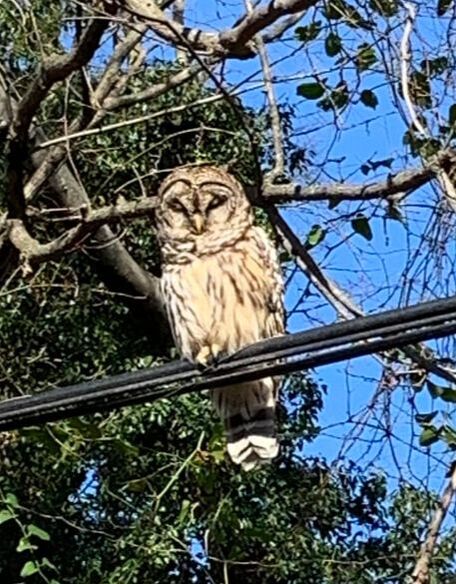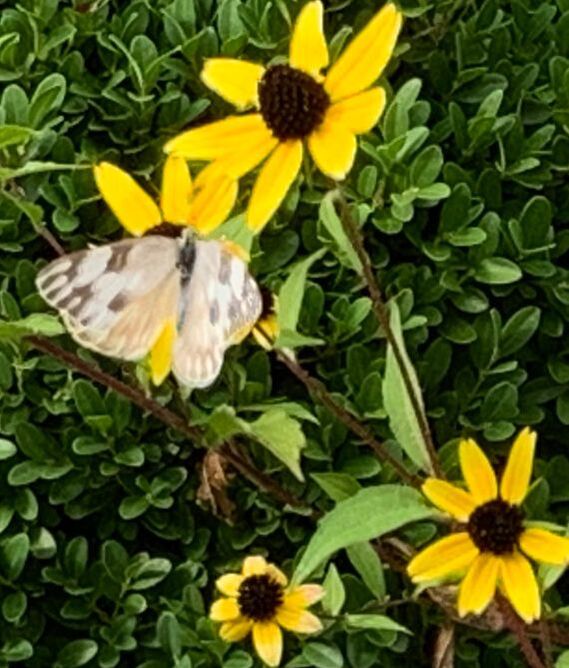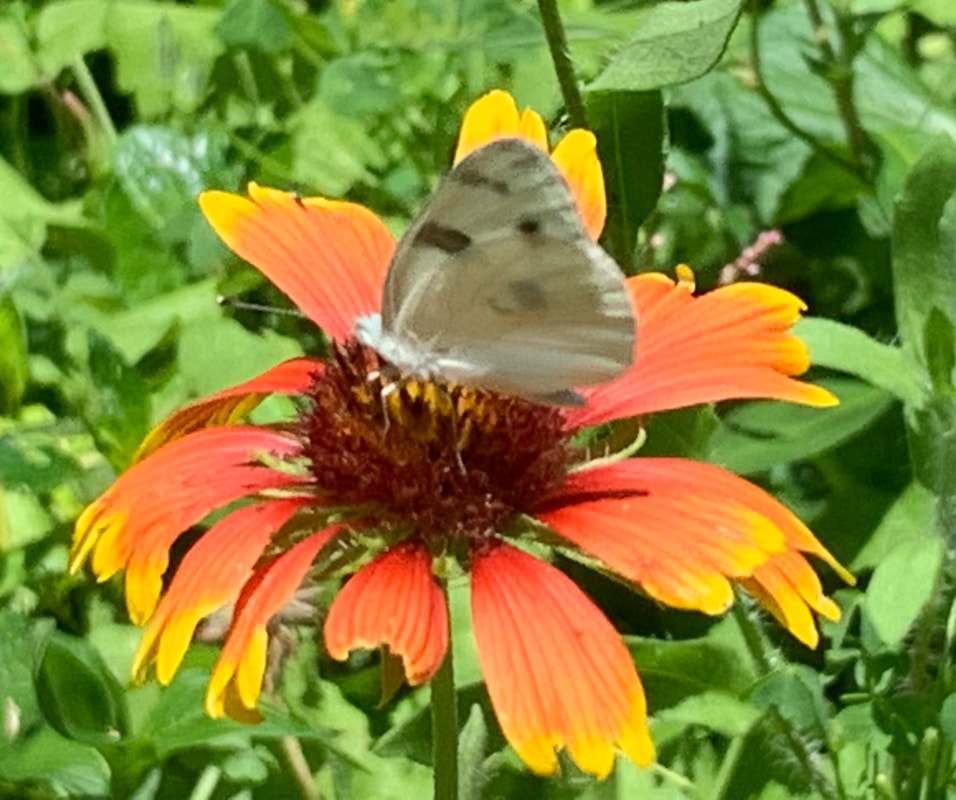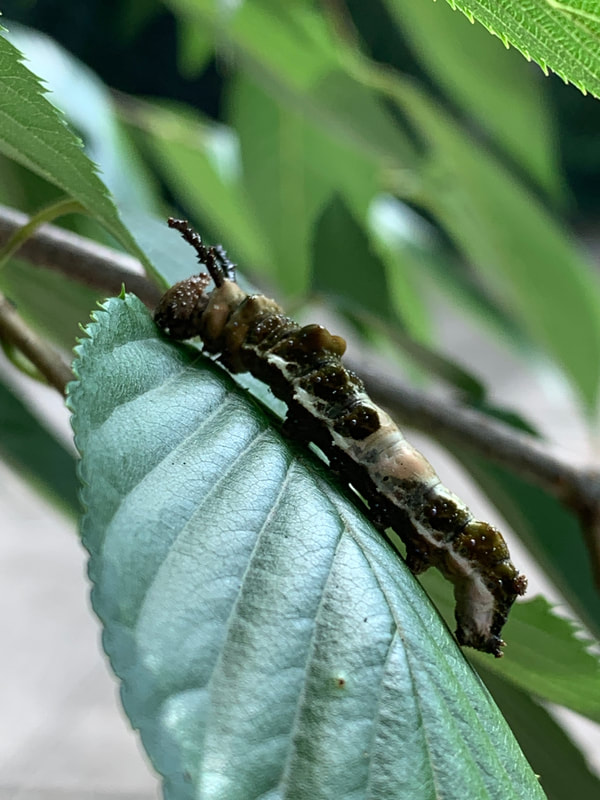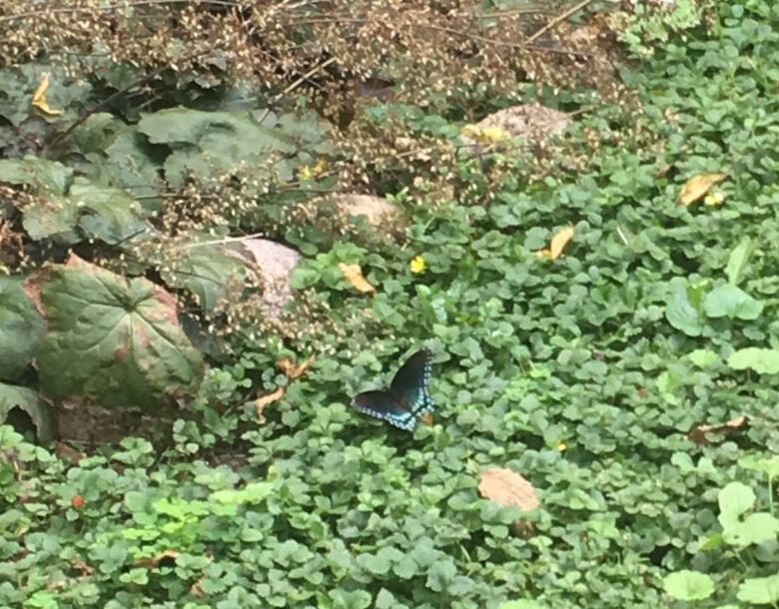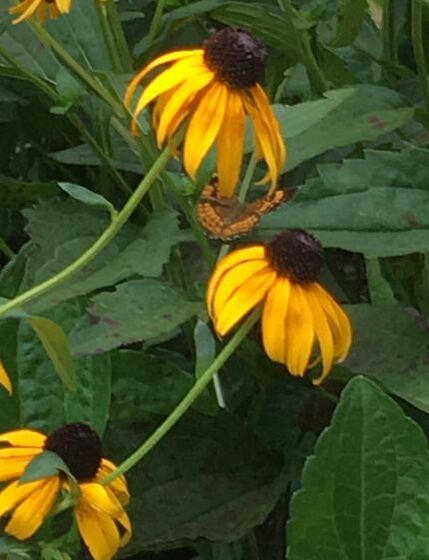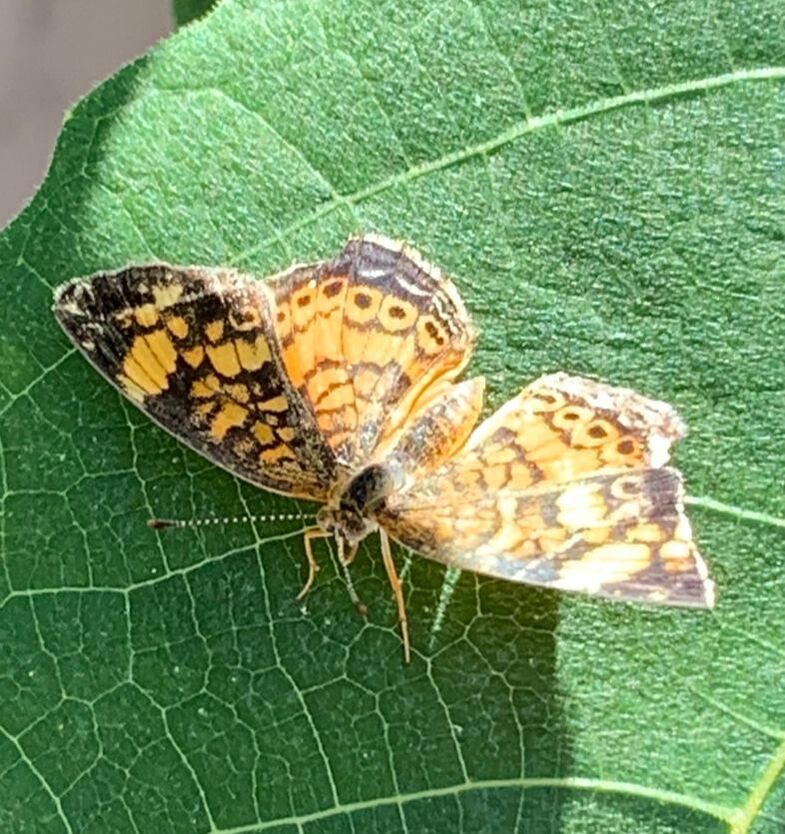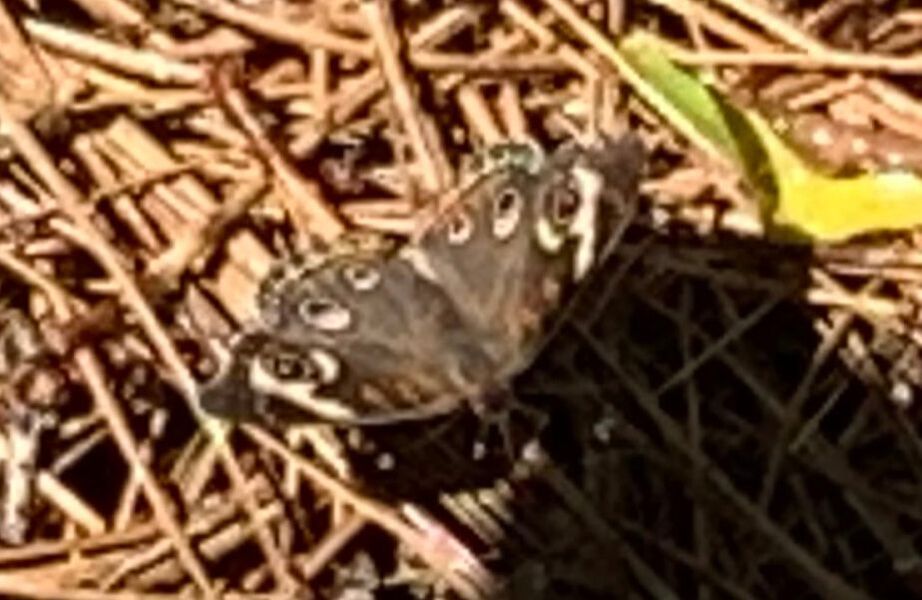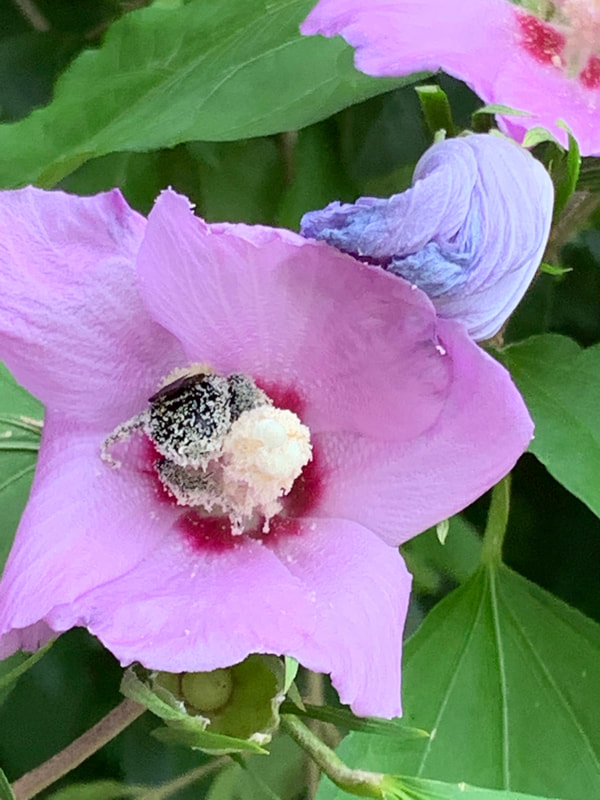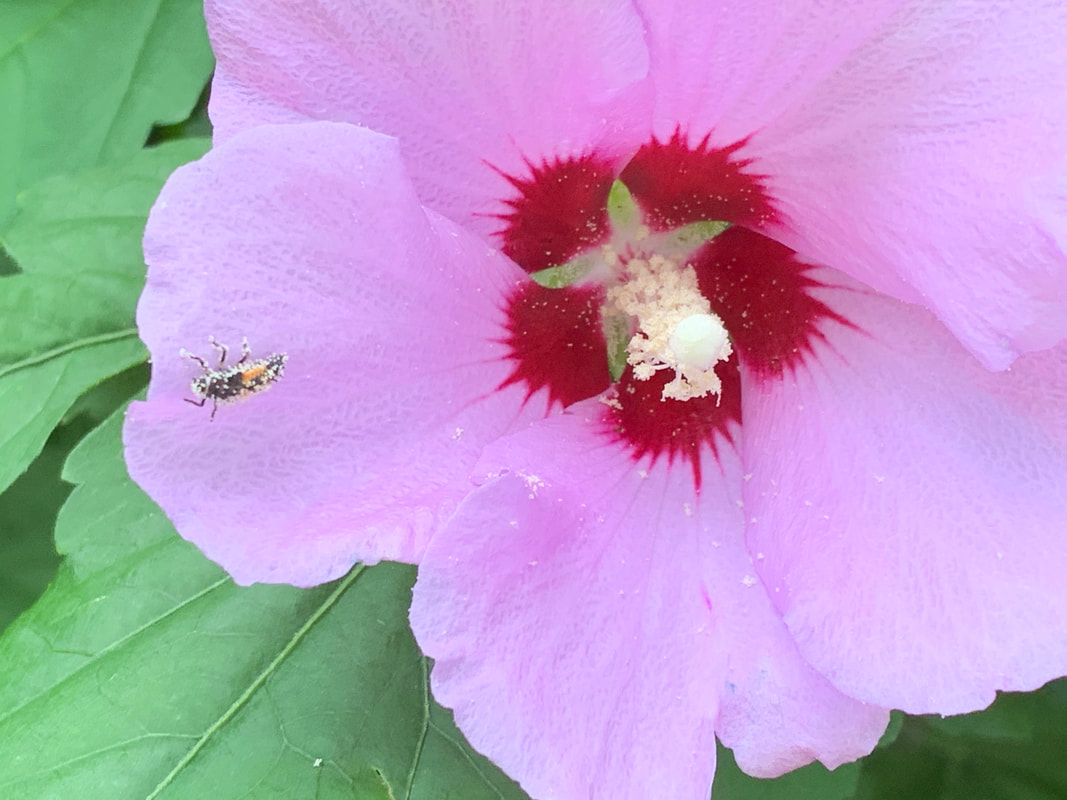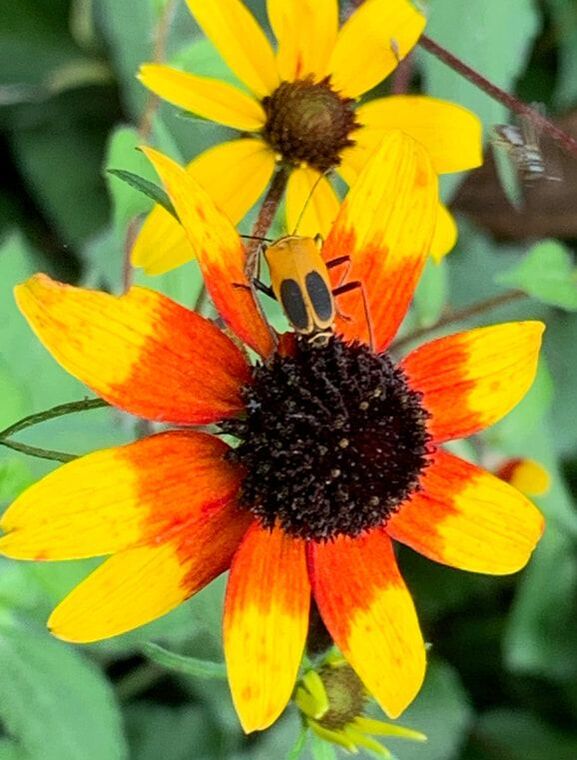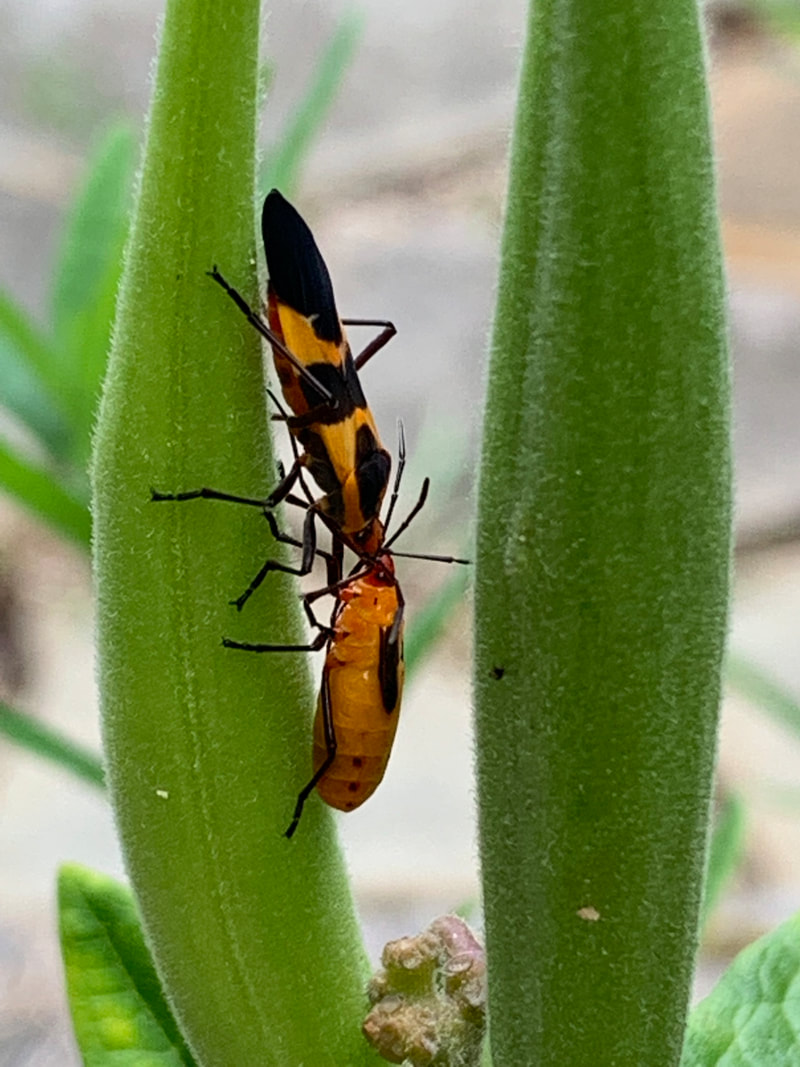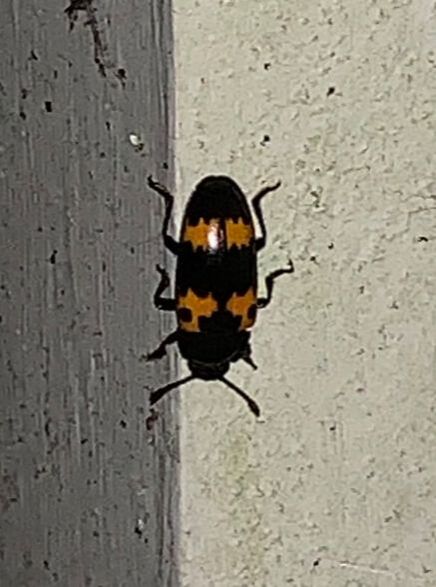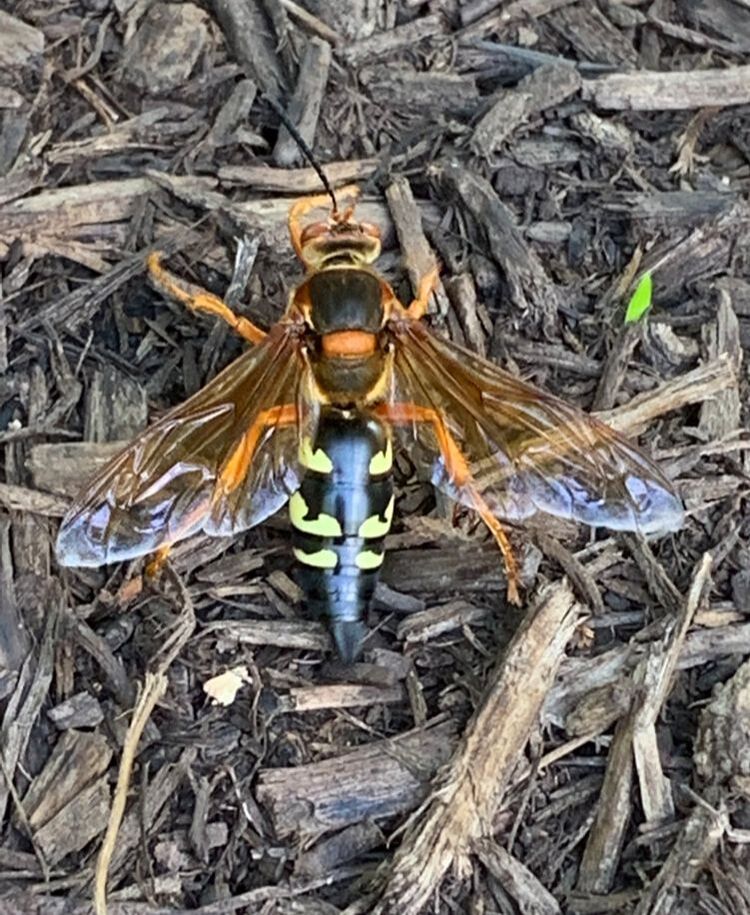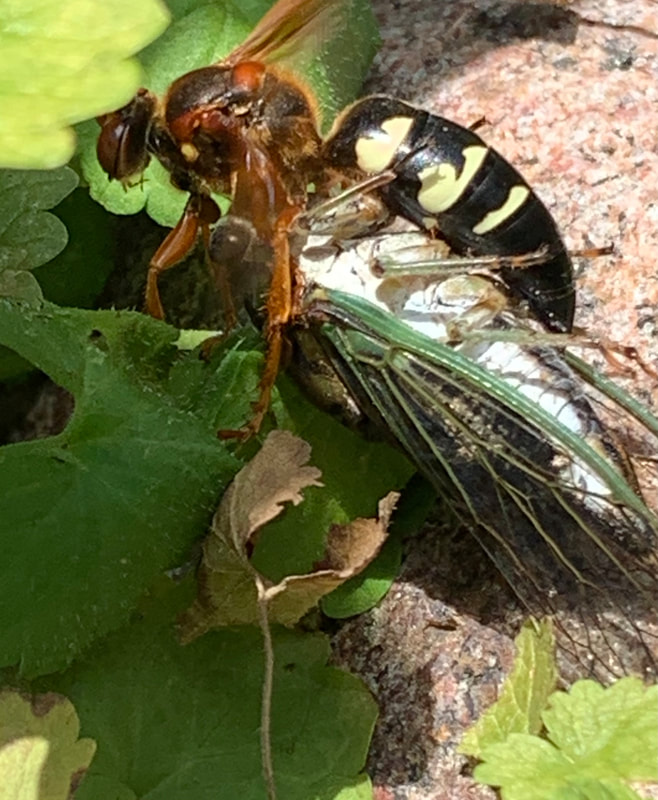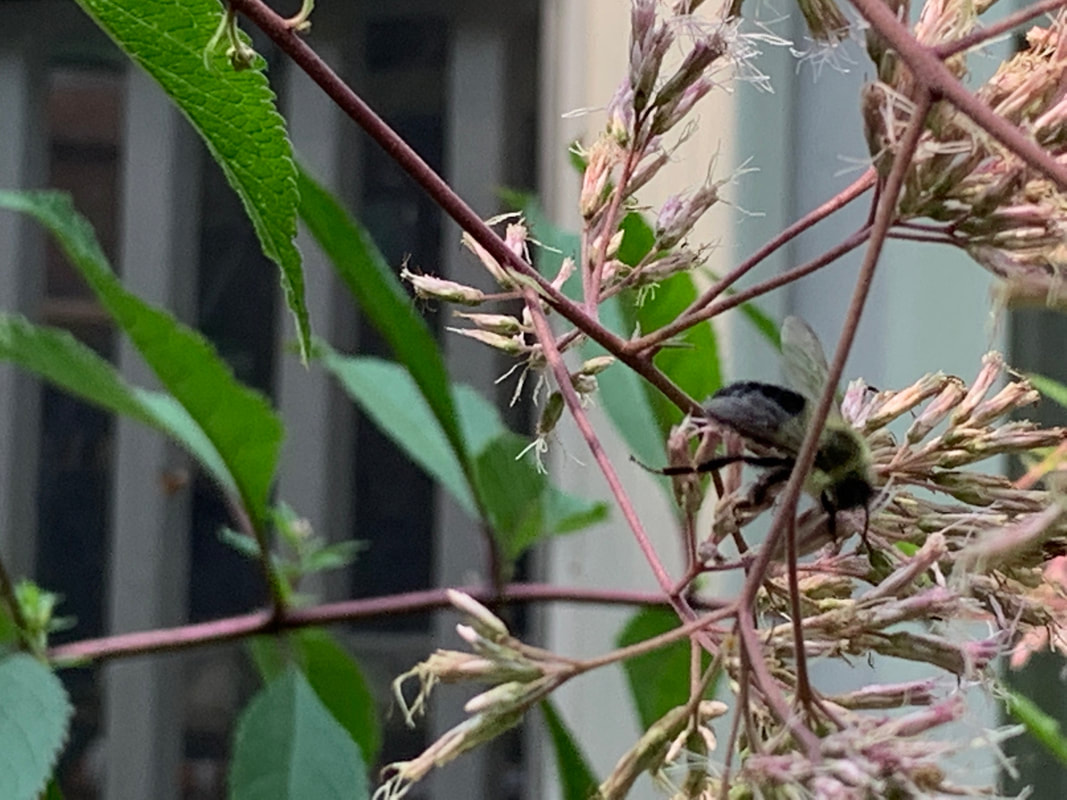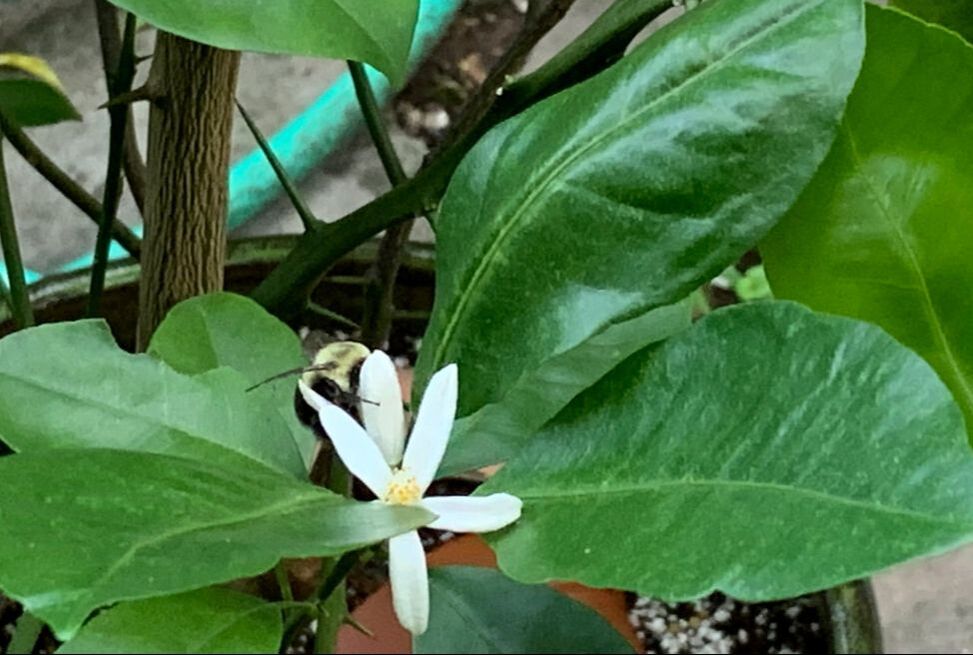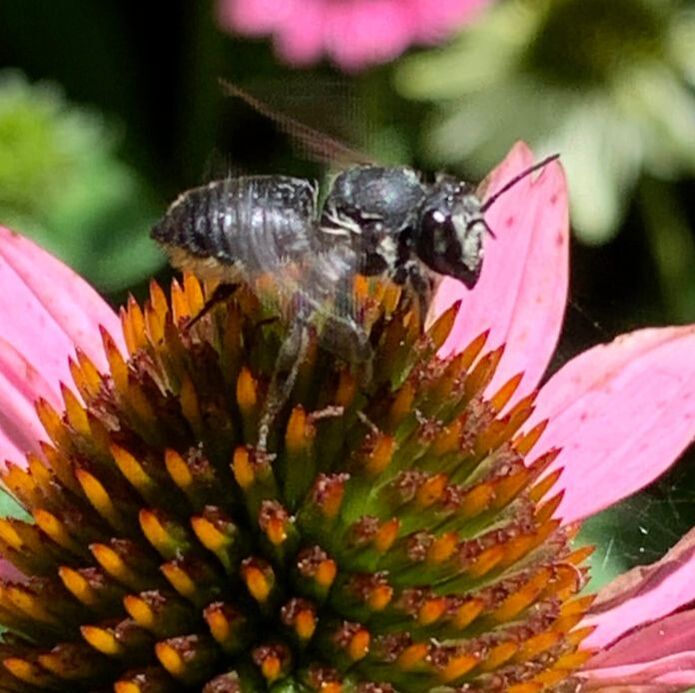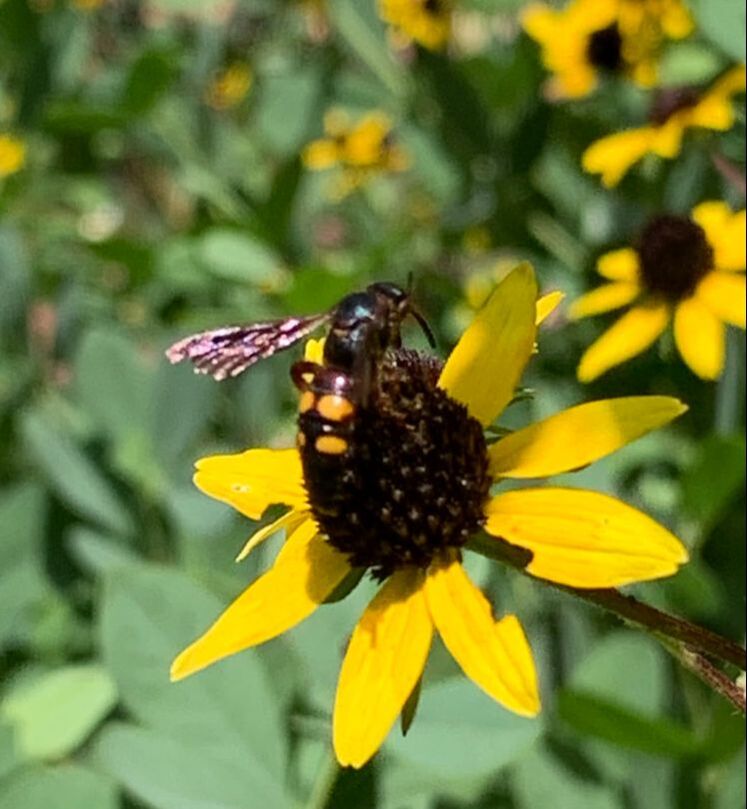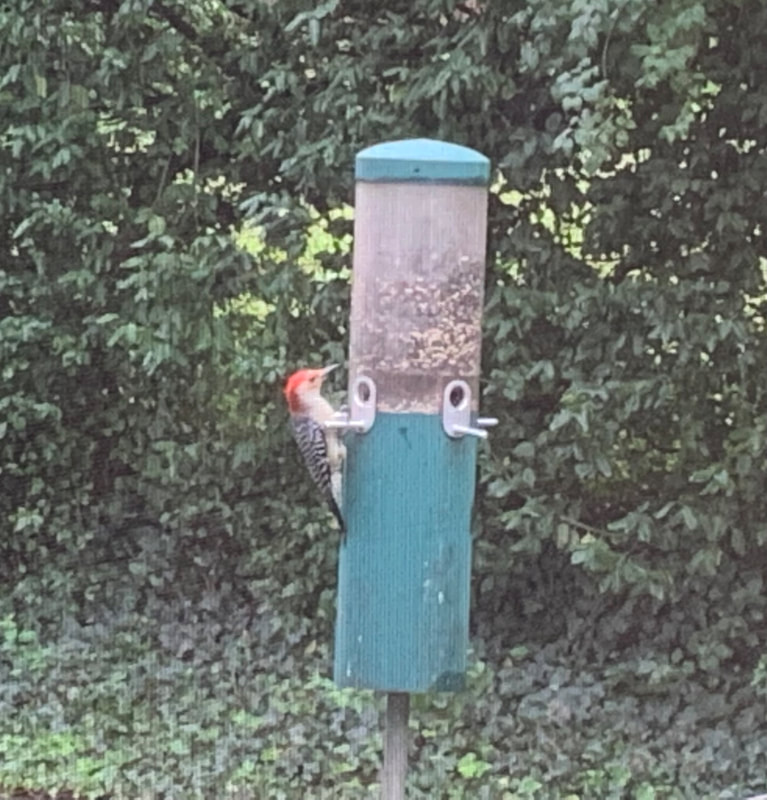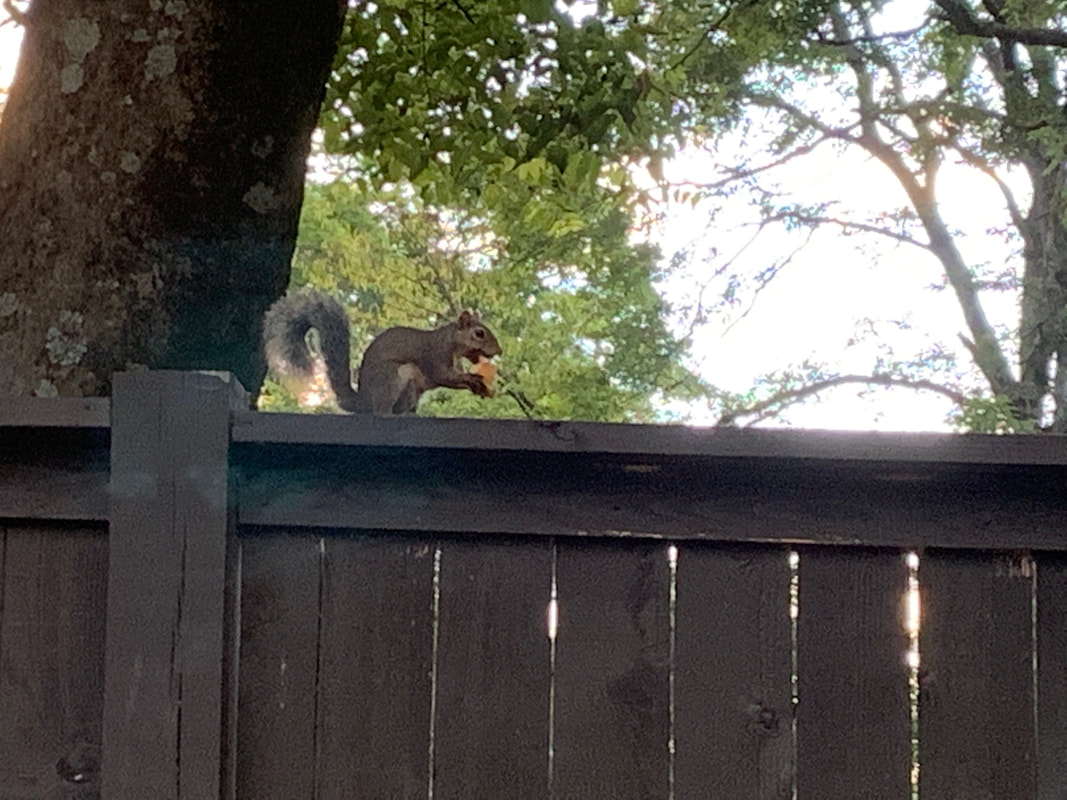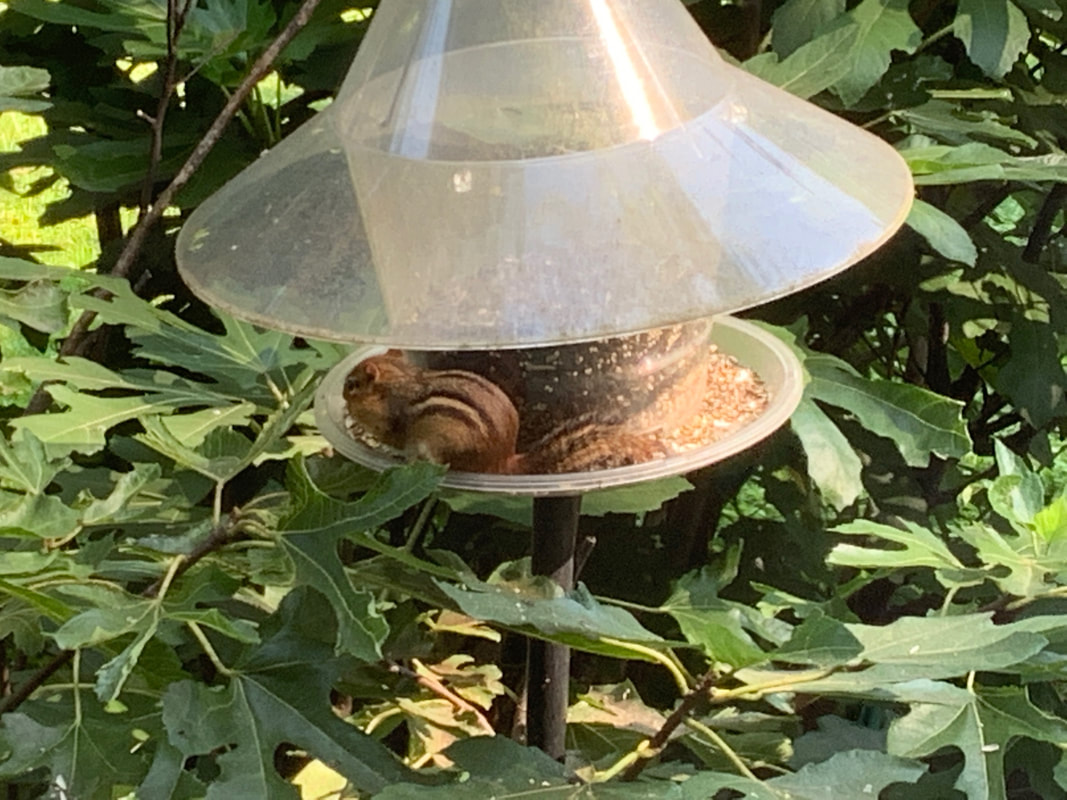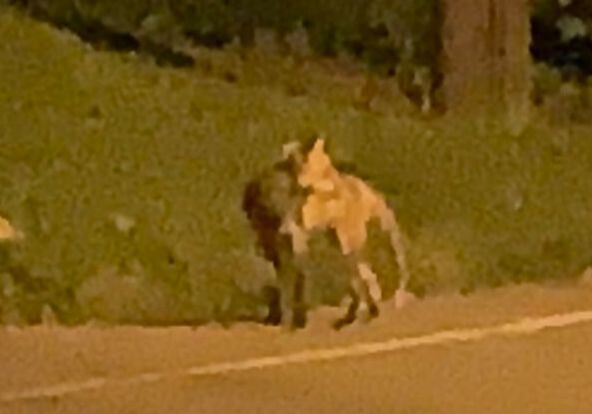Now ... Let us turn from inventory to reflections ... :
© Dr. Mélanie V. Walton, 2021
Contents:
- A Honing of the Eye
- Defining "Weed"
- Volunteers vs. Weeds?
- Some Bug & Wild - Life Here
- Online & Print Weed Resources
A Honing of the Eye:
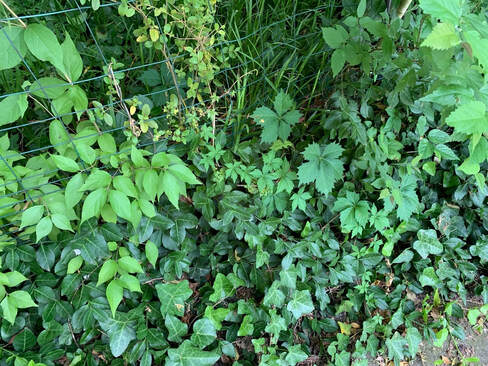 Oh, what a bloody mess!: roughly clockwise from top left: honeysuckle, privet, virginia creeper, sedge, elm, euonymous, ivy
Oh, what a bloody mess!: roughly clockwise from top left: honeysuckle, privet, virginia creeper, sedge, elm, euonymous, ivy
The individual accounts, admittedly, have honed my eye to difference, increased my appreciation, and earned from me a half smile along with that exasperated sigh at their repeated future sightings ...
But such small measures aside ...
There comes an experience (to me, here, not at all uncommonly) to challenge this weedy rethinking as a potential reconnoitering of my weed biases ... it is when I come across a corner like this:
But such small measures aside ...
There comes an experience (to me, here, not at all uncommonly) to challenge this weedy rethinking as a potential reconnoitering of my weed biases ... it is when I come across a corner like this:
It is time--like Lady Philosophy told Boethius who was still weeping before his death bed--for a stronger medicine.*
Such a sight as the chaotic corner of weeds shown here requires a strenuous visual exercise of discernment. For the sea is not just a sea to a sailor, the desert not just a sandy expanse to the well-seasoned nomad, and as mountains vary to the experienced trekker, the jungle has to become for me not just a jungle. In his philosophy of art, Edward Bullough proposed a mental insertion of “psychical distance” into one’s sensory field so to shift from a dulled, blocked reaction to attentive aesthetic reception. Consider, he offered, being in a dense fog at sea: the experience is of acute unpleasantness, one productive of anxiety and direct fear as you strain to see ... but then abstract from the dangers of the lived experience and such can be revealed as a source of intense relish and enjoyment as you “direct the attention to features ‘objectively’ constituting the phenomenon—the veil surrounding you with an opaqueness as of transparent milk … [—] and the experience may acquire, in its uncanny mingling of repose and terror, a flavour of such concentrated poignancy and delight as to contrast sharply with the blind and distempered anxiety of its other aspects.”** An ‘objective’ observation shifts the ‘subjective’ holistic reception of the event, so to come to see (like his foggy expanse) my unruly green mass more as the collective surge of life, not a thankless chore left ever undone ... consider the shelter this provides animals (even if most frequently bunnies escaping my dogs, or perches from which the squirrels can laugh at them), good-bug homes, a green screen for my compost bin ... and then shift perspective again from the assault of a harrowing mass to a radical collective of individual species ... and then I may begin to better appreciate the unique beauty of weeds. So, draw away your twitching to-do listed mind and look freshly, look widely, look without feeling guilt, look close, bend low—though, don't get too close, the chiggers are back—and focus as if blurring oneself outside and backwardly so to re-approach the aesthetic presentation microscopically:
|
... I spy honeysuckle and hibiscus, privet and elm, Euonymous and ivy, sedge and virginia creeper, and, of course, Vox, my weedy-yard-loving terrier-chihuahua who knows all the best chase-able creatures hide back here ...
See, now, how stunted those boxes of crayons made our seeing, making us believe that ‘spring green’ was a single shade? That one has more lemon, that one is friendlier to the dusty blues, this one is a shade of turtle that a child would draw, this other is more authentic to oozing pond life. Basic biology books make out in their line drawings like all cotyledons are a stem’s first globular rounds, but this one looks like a lily pad, that one the tip of a cherub’s arrow. Amongst the burgeoning leaves, some are waxy, some have downy fluff, some are slick, some deeply veined. These are already becoming lobed, those are already developing little tendrils. From the infinite mass and still-slightly-sickening riot of non-planted green I come to individuate numerous offender-specimens I can more or less name, another dozen I’ll have to photograph for looking up later, and, admittedly, a handful more I am now a sucker for, and will let them be. |
* Boethius, The Consolation of Philosophy, trans. Richard Green (Mineola, NY: Dover Pub., 2002), III.1--herein Lady Philosophy shifts her consolation (i.e., blistering Stoic intellectually-curative exercise) from gentle to strong medicine: it will first taste bitter, but then sweet upon digestion, for it will lead him to true happiness.
** Edward Bullough, “‘Psychical Distance’ as a Factor in Art and as an Aesthetic Principle,” 458-467, in Art and its Significance, ed. Stephen David Ross (New York: SUNY Press, 1994), 459.
** Edward Bullough, “‘Psychical Distance’ as a Factor in Art and as an Aesthetic Principle,” 458-467, in Art and its Significance, ed. Stephen David Ross (New York: SUNY Press, 1994), 459.
Defining "Weed"
“A familiar complaint one hears these days is that, for all the modern explosion of interest in gardens, an older aspect of garden appreciation has been forgotten: that of the garden’s role as a bearer of meaning.”* Professor Cooper’s point is superb, and it is his aim in his thoroughly argued A Philosophy of Gardens, but it bears even greater weight when we apply it to the question of ~weeds~ in one’s garden. Is it not the meaning broadcast by a garden of weeds that most makes one shrink overladen beneath the not necessarily herbal tonnage? The meaning emanating from weeds is critical to consider when seeking the definition of “weed.”
* David E. Cooper, A Philosophy of Gardens (Oxford: Clarendon Press, 2006), 108.
* David E. Cooper, A Philosophy of Gardens (Oxford: Clarendon Press, 2006), 108.
Thus, what does it mean, what is a "weed"?
Some of the most common definitions of "weed":
¥ ... is a misplaced plant, or a plant in the wrong place ...
¥ ... is an unappreciated plant, or an undervalued plant ...
¥ ... a wild plant growing where it is not wanted ...
¥ ... an unwanted plant, or an undesirable plant ...
"What is a weed? I have heard it said that there are sixty definitions. For me, a weed is a plant out of place. Or, less tolerantly, call it a foreign aggressor, which is a thing not so mild as a mere escape from cultivation, a visitor that sows itself innocently in a garden bed where you would not choose to plant it."
--Donald Culross Peattie, Flowering Earth (Trinity University Press, 2013).
“We habitually think of weeds as invaders, but in a precise sense they are also part of the heritage or legacy of a place, an ancestral presence, a time-biding genetic bank over which our buildings and tinkerings are just an ephemeral carapace. I still hoick them up when they get in my way, but it’s a capricious assault, tinged with respect and often deflected by a romantic mood.”
-- Richard Mabey, Weeds: In Defense of Nature’s Most Unloved Plants (New York: Harper-Collins, 2010), 183.
“Weeds, those vagrant plants, those wanderers, the uninvited … they have an infinite capacity to heal the earth, to heal our bodies, and maybe just heal our souls too.”
-- Gareth Richards, Weeds: The Beauty and Uses of 50 Vagabond Plants (London: Royal Horticultural Society and Welbeck Publishing Group, 2021, 7.
“Look everywhere, and you will find wild plants in places so unlikely and so unfriendly to growth that you can only be amazed at the toughness and vigor of the plants that survive in the rubble, in the cluttered ‘gardens’ of their own making.”
-- Anne Ophelia Dowden, Wild Green Things in the City: A Book of Weeds (New York: Thomas Y. Crowell Co., 1972), 2.
“A man’s nature runs either to herbs or weeds; therefore let him seasonably water the one, and destroy the other.”
--Francis Bacon (1561–1626), “XXXVIII: Of Nature in Men,” in Essays, Civil and Moral (The Harvard Classics: 1909–14), available --HERE--.
“Weeds are everywhere. We may try to bend nature to our will, but on the peripheries of herbicide-drenched fields, squeezed between paving slabs and seeded into the crevices of city walls, these often disregarded plants grow and prosper. They are the tough underclass of the plant world, bullying their way into drainage systems, poisoning meadowland, stealing essential nutrients and taking a stranglehold on plants we deem legitimate. Yet in those far-flung places where wilderness remains we often do not bother to consider weeds at all. And they require our attention. Weeds exist only in relation to ourselves.”
--Nina Edwards, Weeds (London: Reaktion Books LTD, 2015), 7.
A Selection of not-at-all-minded Weed/Volunteers
|
|
|
Some of the Bug & Wild - Life About Here:
A Collection of Online & Print Resources:
Plant Identification Resources and Tools:
- The Weed Science Society of America: ~~HERE~~
- Plant Net identifier: ~~HERE~~
- NatureGate plant id: ~~HERE~~
- Missouri Botanical Garden Plant Finder: ~~HERE~~
- University of Missouri, Division of Plant Sciences Weed ID: ~~HERE~~
- North Carolina Extension Gardener Plant Toolbox: ~~HERE~~
- Virginia Tech College of Agriculture and Life Sciences Weed ID: ~~HERE~~
- Lady Bird Johnson Wildflower Center Plant Database: ~~HERE~~
- Plants for a Future Database: ~~HERE~~
- Minnesota Wildflowers Field Guide: ~~HERE~~
- Southeastern Flora Plant ID Resource: ~~HERE~~
- Invasive Plant Atlas of the U.S.: ~~HERE~~
- Wildflowers of the U.S., TN page: ~~HERE~~
- Native Plants for Tennessee: ~~HERE~~
- Tennessee Native Plant Society, resources: ~~HERE~~
- North American Native Plant Society, invaders: ~~HERE~~
- On Botanical Names: ~~HERE~~
- Dictionary of Old English Plant Names: ~~HERE~~
- Residue of Alchemy in Botany: ~~HERE~~
- British Library Illustrated Herbal: ~~HERE~~
- Botanical Art & Artists Herbals: ~~HERE~~
- Natural History Museum, London (Botanical Art and Illustrations from HSM Endeavour): ~~HERE~~
- Deutsche Gartenbaubibliothek e.V. (Digital Historic Garden Literature, a collection of links): ~~HERE~~
- Det KGL Bibliotek (the Flora Danica): ~~HERE~~
- Biodiversity Heritage Library (BHL): ~~HERE~~
- Agriculture and Horticulture Development Board (AHDB), Weed ID Guide (Warwickshire, UK: Agriculture and Horticulture Development Board, 2016).
- David E. Allen and Gabrielle Hatfield, Medicinal Plants in Folk Tradition: An Ethnobotany of Britain and Ireland (Portland, OR: Timber Press, 2004).
- Allan M. Armitage, Of Naked Ladies and Forget-me-Nots: The Stories behind the Common Names of some of our Favorite Plants (Athens, GA: Allan Armitage, 2017).
- Francis Bacon, “XXXVIII: Of Nature in Men,” in Essays, Civil and Moral (The Harvard Classics: 1909–14; New York: P. F. Collier & Son, 1937).
- Ross Bayton and Simon Maughan, Plant Families: A Guide for Gardeners and Botanists (Chicago: The University of Chicago Press, 2017).
- Margret Berger, ed., Hildegard of Bingen: On Natural Philosophy and Medicine: Selections from Cause et Cure (Cambridge: D. S. Brewer, 1999).
- Ruth Binney, Plant Lore and Legend: The Wisdom and Wonder of Plants and Flowers Revealed (Garden City, NY: Dover Publications, 2016).
- Brian Capon, Botany for Gardeners (Portland: Timber Press, 2005).
- Klaus Carl, ed., Herbarium (New York: Parkstone Press, 2011)—plates from Hortus Eystettensis of Basilius Besler, 1613.
- Joseph A. Cocannouer, Weeds: Guardians of the Soil (Old Greenwich, CN: The Devin-Adair Co., 1950, 1980).
- William Coles, The Art of Simpling: An introduction to the Knowledge and Gathering of Plants, (Pomeroy, WA: Health Research Books, 1986)—a reprint of that printed in London by J. G. for Nath: Brook, 1656.
- Brian Copenhaver, ed., The Book of Magic: From Antiquity to the Enlightenment (New York: Penguin Books, 2015).
- Richard Dickinson and France Royer, Weeds of North America (Chicago: University of Chicago Press, 2014).
- Anne Ophelia Dowden, Wild Green Things in the City: A Book of Weeds (New York: Thomas Y. Crowell Co., 1972).
- Nina Edwards, Weeds (London: Reaktion Books LTD, 2015).
- Ralph Waldo Emerson, “The Fortune of the Republic,” §XXX., 1-76 marginal pagination, in Ralph Waldo Emerson (1803-1882): The Complete Works, Vol. XI, Miscellanies (Ann Arbor: University of Michigan Press, 2006).
- Nicholas Everett, ed., The Alphabet of Galen: Pharmacy from Antiquity to the Middle Ages (Toronto: University of Toronto Press, 2012).
- Gail Harland, The Weeder’s Digest: Identifying and Enjoying Edible Weeds (Totnes, Devon, England: Green Books, 2012).
- Alice Henkel, Weeds Used in Medicine, U. S. Department of Agriculture, Farmers’ Bulletin No.188 (Washington D.C.: Government Printing Office, 1917), digitized by the Missouri Botanical Garden, available ~~HERE~~.
- Dennis Horn, Tavia Cathcart, Thomas E. Hemmerly, and David Duhl, Wildflowers of Tennessee the Ohio Valley and the Southern Appalachians (Auburn, WA: Lone Pine Publishing, 2018).
- Richard Mabey, Weeds: In Defense of Nature’s Most Unloved Plants (New York: Harper-Collins, 2010). Available ~~HERE~~.
- ----, The Cabaret of Plants: Forty Thousand Years of Plant Life and the Human Imagination (New York: W. W. Norton & Company, 2015). Available ~~HERE~~.
- Teresa McLean, Medieval English Gardens (New York: The Viking Press, 1980).
- Bill Neal, Gardener’s Latin (Chapel Hill: Algonquin Books, 1992).
- Piet Oudolf and Rick Darke, Gardens of the High Line: Elevating the Nature of Modern Landscapes (Portland, OR: Timber Press, 2017).
- Michael Pollan, Second Nature: A Gardener’s Education (New York: Grove Press, 1991).
- Steven R. Radosevich, Jodie S. Holt, and Claudio M. Ghersa, Ecology of Weeds and Invasive Plants: Relationship to Agriculture and Natural Resource Management (Hoboken, NJ: Wiley-Interscience, John Wiley & Sons, Inc., 2007).
- Reza Ramyar, “Learning from Tradition: The Role of Environmental Perception Layers in Space Making—The Case of the Persian Garden,” Journal of Urban Management 9 (2020): 238-39.
- Gareth Richards, Weeds: The Beauty and Uses of 50 Vagabond Plants (London: Royal Horticultural Society and Welbeck Publishing Group, 2021).
- John Charles Ryan, Plants in Contemporary Poetry: Ecocritism and the Botanical Imagination (New York: Routledge, 2018).
- Arlo I. Smith, A Guide to Wildflowers of the Mid-South: West Tennessee into Central Arkansas and south through Alabama and into East Texas (Memphis: Memphis State University Press, 1979).
- Huron H. Smith, Ethnobotany of the Menomini Indians (Westport, CN: Greenwood Press, 1923, reprint 1970).
- ----, Ethnobotany of the Ojibwe Indians (Milwaukee, WI: Order of the Board of Trustees, Public Museum of the City of Milwaukee, 1932).
- Robyn Stacey and Ashley Hay, Herbarium (Cambridge: Cambridge University Press, 2004).
- Malcolm Stuart, ed., The Encyclopedia of Herbs and Herbalism (London: Orbis Publishing, 1979).
- Douglas W. Tallamy, Bringing Nature Home: How you can Sustain Wildlife with Native Plants (Portland: Timber Press, 2009). Available ~~HERE~~
- ----, The Nature of Oaks: The Rich Ecology of Our Most Essential Native Trees (Portland: Timber Press, 2021). Available ~~HERE~~.
- Ken Thompson, The Book of Weeds: How to Deal with Plants that Behave Badly (London: DK Books, 2009).
- Anne Van Arsdall, ed., A New Translation of the Old English Herbarium (New York: Routledge, 2002).
- To be continued ...
|
© Dr. Mélanie V. Walton, 2021 |
Site powered by Weebly. Managed by MacHighway
